阅读:0
听报道
内源“吗啡”样分子的发现
吗啡有神奇的镇痛作用。
通过研究吗啡的作用,发现体内有类似吗啡作用的分子,是二十世纪药理学最重要的发现之一。
没有人因为它获诺奖,可能是因为内部的优先权争论。其中最无争议(但被其他人争议所“耽误”)的是当时在苏格兰Aberdeen大学的药理系主任Hans Kosterlitz(科瑟立兹,1903-1996)与药理系讲师John Hughes(休斯,1942-)。
Hans Kosterlitz(老科)去世二十年后,他的儿子Michael Kosterlitz(小科,1943-)获诺贝尔物理奖。
药物作用机理
德国化学家Friedrich Gren (1760-1798)于1791年提出药物学(materia medica)和药理学(pharmacology)的区别:描述和收集药物为药物学,研究药物作用的科学为药理学。
法兰西学院生理学家François Magendie (1783-1855)从1831年起先在动物做药物实验,从动物得到能够预计效果之后再在人身上做试验,以生理学途径建立了实验药理学。他的学生Claude Bernard (1813–1878)对美洲筒箭毒作用和一氧化碳结合血红蛋白的研究也同样从生理途径研究药理学。这样不仅研究药物作用机理,也推动生理学原理研究。
德国科学家Rudolf Buchheim (1820–1879)在药物学的基础上,建立了实验室,1865年正式命名为药理学研究所,成为世界上第一次独立的药理学研究所,他培养了九十多个学生(Habermann,1974;Jansone et al.,2016)。他的学生Oswald Schmiedeberg (1838-1921)培养了来自二十多个国家一百二十多位学生,让药理学传遍世界。他的美国学生John Jacob Abel (1857-1938)留学德国7年,1891年成为美国第一位药理学教授、1893年成为美国第一位药理系主任,创办了《生物化学杂志》(JBC)和《药理学与实验治疗学杂志》(JPET)。Schmiedeberg的另一学生Hans Horst Meyer (1853-1939)最著名的工作是提出全身麻醉药的药效与其脂溶性相关,可能是因为全麻药融在细胞脂膜而干扰神经细胞的功能。
镇痛作用机理
痛觉对于保护人类非常重要,没有痛觉的人难以长期健康生活。先天缺乏痛觉的人会出现认知偏差,难以活到成年(Dearborn, 1932;Landrieu, Said and Allaire,1990;Nagasako, Oaklander and Dworkin,2003;Cox et al., 2006)。痛觉又经常让人们难受,人们经常希望能够有镇痛的方法。
一般来说,伤害性刺激由于其物理、化学性质可以特异地激活痛觉神经末梢,由痛觉神经传导信息至脊髓,上传至脑,经过引起痛觉(Basbaum et al., 2009)。通过长期的研究证明,痛觉传导通路与其他体躯感觉如温度、触压、痒的传导通路是分开的,而不是其他感觉过度强烈后成为痛觉(Perl, 2007)。对于痛觉传导神经非常重要的钠离子通道蛋白Nav1.7及其基因SCN9A已被发现,其功能增加的突变导致自发或轻微刺激就出现痛觉(Yang et al., 2004),而其缺失导致无痛(Cox et al., 2006)。因为它是痛觉神经特异的,所以其突变不影响温度、触压等其他感觉。
镇痛的药物可以在外周发挥镇痛作用、也可能在中枢发挥镇痛作用。
1964年,当时在美国Miles药厂工作的林可胜(Robert KS Lim, 1897-1969)发明了区分药物是在中枢还是在外周起镇痛作用的方法(Lim et al., 1964)。林可胜的实验设计是:将一只狗(受体狗,R)的脾脏完全与其自身血流分开,而接受供体狗(D)的血流灌注。其他照常(也就是说,R的其他器官包括中枢神经系统继续由R的血流灌注,R的脾神经也原封不动)。已知通过血液给R的脾注射缓激肽会引起痛疼(通过狗叫、呼吸和血压监测)。在给D注射阿司匹林时,可以抑制痛觉,而给R注射阿司匹林时,不能抑制痛觉。这些实验说明阿司匹林的作用在脾脏(外周)发挥,而不是在中枢神经系统发挥。同样的实验,如果注射吗啡,只有注射到R才能抑制痛觉,而注射到D没有用,说明吗啡镇痛作用不在外周发挥,而可能在中枢发挥(Lim et al., 1964)。
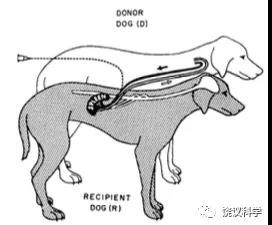
林可胜通过这一优美实验设计建立了鉴定中枢和外周镇痛的一个标准模型,可以鉴定很多药物的外周、中枢差别(Lim,1968)。林可胜还有两个实验证明阿司匹林的外周镇痛作用:脾脏注射致痛的缓激肽,引起脾感觉神经发放冲突增加,这一作用可以被阿司匹林所阻断,不能被吗啡所阻断;脾脏注射缓激肽引起痛觉,如果阿司匹林通过与缓激肽同样的局部途径注射进入脾脏,其镇痛所需要的剂量(3.8 mg/kg)低于静脉注射阿司匹林能够镇痛剂量(50 mg/kg)的10%,而八倍(30 mg/kg)的阿司匹林注射到头颈动脉也不能引起镇痛(Limet al., 1964;Guzmanet al., 1964)。与此相反,在头颈动脉注射吗啡引起镇痛所需剂量低于局部脾脏注射吗啡所需的剂量(Lim,1970)。
林可胜用三个实验证明阿司匹林镇痛作用的位点在外周,是阿司匹林研究的里程碑之一。阿司匹林是如何在外周发挥镇痛作用的呢?其生物化学机理是抑制前列腺素的合成(Vane, 1971; Smith and Willis, 1971),而有些种类的前列腺素可以刺激痛觉系统的外周神经末梢,因此阿司匹林能够缓解一部分疾病的痛疼。
林可胜的研究结果也支持了1962年中国科学家的发现:吗啡在中枢神经系统发挥镇痛作用。
吗啡镇痛位点
研究吗啡促进了对痛觉的理解。
一些研究表明,吗啡镇痛的作用位点在脑内(Wikler, 1950;Lockett and Davis, 1958)。例如中国科学院药物研究所的周金煦和胥彬发现脑室内注射吗啡产生镇痛作用所需要的药量是皮下注射产生镇痛作用的百分之一,支持吗啡可能在脑内起镇痛作用(Chou and Hsu,1959)。吗啡镇痛作用的位点不是大脑皮层或下丘脑(Masserman, 1939)。但不清楚吗啡作用具体在脑内什么部位。
1962年,中科院药物所的研究生邹冈(1932-1999)与其导师张昌绍(1906-1967)在《生理学报》以中文全文和英文摘要发表其研究结果(Tsou and Jang,1962),1964年再以英文发表全文:“脑室内或脑组织内微量注射吗啡的镇痛效应”(Tsou and Jang,1964)。

邹和张首先给家兔脑室内注射吗啡,可以观察到镇痛作用。比较注射到脑室和注射到静脉后的吗啡镇痛作用,发现注射到脑室产生镇痛作用所需要的吗啡剂量是注射到静脉所需剂量的1/500-1/1000,而镇痛作用时间也是脑室注射的更长。将脑室注射有效的剂量相同的吗啡放在滤纸上贴在大脑皮层没有镇痛作用。他们在皮层下多个部位注射微量吗啡,发现吗啡注射到第三脑室周围灰质有显著镇痛作用,而且可以被吗啡拮抗剂丙烯吗啡所抑制。
1969年,美国科学家发现电刺激大鼠中脑中央灰质可以镇痛(Reynolds,1969),这一发现说明脑内有内源镇痛机制,在电刺激激动下可以主动抑制痛觉。这一发现得到广泛验证:鼠(Mayer et al., 1971;Balagura and Ralph,1973;Melzack and Melinkoff,1974)、猫(Liebeskind et al.,1973;Oliveras et al.,1973)、猴(Goodman and Holcombe,1976)、人(Mayer DJ and Liebeskind JC (1974))。
电刺激引起镇痛的部位,与邹冈和张昌绍发现的吗啡镇痛部位相同:中脑导水管周围灰质(periaqueductal gray,PAG)(Mayer and Price,1976;Hayeset al.,1979)。而且,电刺激PAG的镇痛作用可以被吗啡拮抗剂所抑制(Adams,1976;Akil, Maycr and Liebeskind,1976);Hosobuchi, Adams and Linchitz,1977;Richardson and Akil,1977;Lewis and Gebhart,1977)。可以推论内源镇痛系统是由吗啡样的物质所介导。
阿片受体
按药理学的推论和立体异构活性的差别(Beckett,1952),阿片类的分子发挥作用的最简单解释是作用于靶细胞的特异受体(Beckett and Casy,1954)。
1971年,为了探寻阿片受体,斯坦福大学药理系Avram Goldstein(1919-2012)发明了检测脑内阿片受体的方法。他们设计:放射性同位素标记阿片类分子,利用阿片类分子的立体特异性(一般D(-)构型的有作用,L(+)构型的同分异构体无作用),在将放射性有效阿片类分子与脑组织细胞结合的时候,加百倍的无标记的D(-)构型的同一分子,应该可以竞争放射性同位素标记的药物与细胞上特异受体的结合,而如果加百倍的无标记的L(+)构型的同一分子,应该不能竞争放射性同位素标记的药物与细胞上特异受体的结合,而能够减少其他非特异的结合,这样就能发现特异结合的受体(Goldstein,Lowney and Pal,1971)。这一方法行之有效,但Goldstein等最初用的标记的阿片类分子被同位素标记的比率较低,实验结果不好。
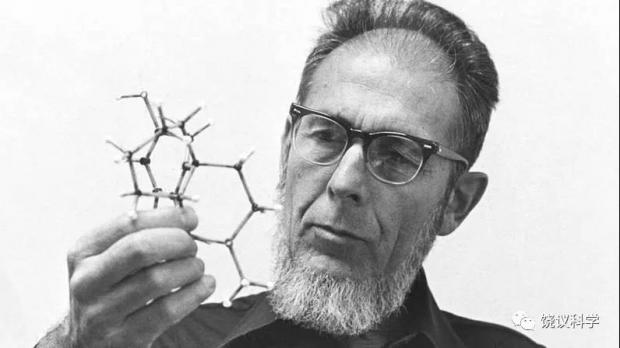
1973年,三个实验室用类似方法,用同位素标记效率更高的阿片类分子检测到特异的阿片受体。瑞典Uppsala大学的Lars Terenius(1940-)用氚标记的双氢吗啡(3H DHM)与来自脑的突触体膜制备进行结合实验,事先可以给老鼠多天注射无同位素标记的左旋或右旋吗啡拮抗剂methadone,发现可以被有活性的左旋methadone所竞争的结合(Terenius,1973a)。同一实验,可以直接在结合实验时加立体异构的阿片类分子,可以观察到立体异构特异的竞争性抑制,也可以观察到非阿片类分子不能特异地竞争抑制DHM与突触体膜制备的结合(Terenius,1973b)。
美国霍普金斯大学医学院的Candace Pert(1946-2013)和Solomon Snyder(1938-)用氚标记的吗啡拮抗剂纳洛酮与大鼠、小鼠或豚鼠的脑匀浆做结合实验,可以被D(-)构型的有活性的阿片类分子(如levorphanol)所抑制、不能被L(+)构型的无活性的阿片类分子(如dextrorphan)所抑制,也不能被胆碱、去甲肾上腺素、组织胺、五羟色胺等所抑制(Pert and Snyder,1973)。他们还发现,如果比较氚标纳洛酮与豚鼠小肠或与脑的结合,levorphanol抑制脑组织与氚标纳洛酮结合的强度40倍于其抑制小肠与氚标纳洛酮的结合,levorphanol抑制脑组织与氚标纳洛酮结合的强度500倍于其抑制小肠与氚标纳洛酮的结合。而在脑与氚标纳洛酮结合实验中,levorphanol与dextrorphan差别有4000倍,而在小肠与氚标纳洛酮结合实验中,levorphanol与dextrorphan差别仅500倍。这些结果提示脑内和小肠的阿片受体有所不同。不同脑区,阿片受体的含量不同(Pert and Snyder,1973)。
美国纽约大学的犹太裔药理学家Eric Simon(1924-2020)等用氚标记当时作用最强的吗啡样分子etorphine,可以与大鼠脑匀浆进行可饱和的、可以被立体异构特异的分子所抑制,抑制强度基本与激动剂、拮抗剂强度相关(Simon, Hiller and Edelman,1973)。
1971至1973年的研究证明:脑内存在特异的与吗啡类分子结合的物质,很可能是介导吗啡药理作用的受体。
内源性阿片样物质
1960年,美国威斯康辛大学的科学家发现垂体后叶含增强吗啡样物质镇痛作用的活性(Murray and Miller,1960)。
德国犹太裔科学家Hans Kosterlitz(1903-1996)于1934年不得不离开柏林Charité医院,移民苏格兰加入Aberdeen大学生理系,1968年他创立其药理系并任第一任系主任。1973年退休后,他继续有实验室,研究成瘾药物。早先,他和一些药理学家就思考过身体多个组织对吗啡有反应提示可能存在内源性吗啡样物质,而1973年阿片受体被证明,更提示受体不应该是为植物来源的生物碱吗啡所存在,而应该有内源性配体。他与药理系讲师John Hughes(1942-)讨论分离纯化内源性阿片样物质:用灵敏的检测方式、用拮抗剂保证特异性(Kosterlitz,1979)。
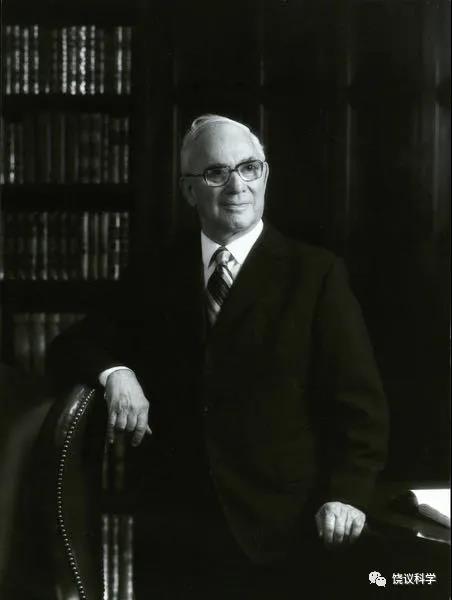
Hughes和Kosterlitz没有用放射性同位素的受体结合实验,而是用传统的生物检定(bioassays):吗啡可以引起豚鼠回肠收缩(Trendelenburg,1917;Schaumann,1955;Kosterlitz and Robinson,1955),抑制刺激神经引起的猫的瞬膜平滑肌收缩(Trendelenburg,1957),抑制肾上腺素能神经兴奋引起的小鼠输精管收缩(Henderson, Hughes and Kosterlitz,1972;Hughes, Kosterlitz and Leslie,1975)。这些作用见效比放射性标记的配体结合实验要更快,Hughes在兔、豚鼠、大鼠、猪脑检测到有吗啡样生物活性的分子量小于700道尔顿的分子,其作用被纳洛酮等三种阿片受体拮抗剂所抑制,可以被多肽水解酶所降解(Hughes,1975)。
瑞典Uppsala大学的Terenius和Wahlström用他们1973年建立的氚标双氢吗啡与大鼠脑突触细胞膜结合实验检测,发现脑内有分子量在1000到1200道尔顿的肽链物质可以竞争氚标双氢吗啡结合脑匀浆(Terenius and Wahlström,1975)。
1975年5月24日,三个课题组同时在同期《生命科学》杂志上发表4篇文章,报道他们纯化内源性阿片样物质的进展。Hughes等从猪脑纯化到一个分子量在1000至1200道尔顿的多肽,在小鼠输精管上具有吗啡样的活性,其活性可以被阿片受体拮抗剂所阻断,而且依赖拮抗剂的立体异构。他们将之命名为脑啡肽(encephalin),其分布并不限于中枢神经系统,而与阿片受体分布相关,所有也应该与吗啡一样具有镇痛和其他中枢神经系统作用之外的作用(Hugheset al.,1975)。用竞争3H纳洛酮和3H双氢吗啡结合脑匀浆为检测方法,Pasternak、Goodman和Snyder 从大鼠和小牛脑分离到“吗啡样物质”(MLF),其分布与阿片受体高度相关(例如纹状体的阿片受体最多,MLF也最多),存在于突触体亚细胞制备中,可以被多肽酶降解,分子量约1000道尔顿(Pasternak, Goodman and Snyder,1975)。Goldstein实验室从猪的垂体分离到具有阿片活性的物质,在豚鼠肠道肌肉和小鼠输精管有阿片样活性,也能够竞争性抑制3H etorphine与脑组织的结合,其作用可以被立体异构特异的阿片受体拮抗剂所阻断(Teschemacheret al.,1975)。因为移植垂体含多种生物活性肽类分子,他们进一步检测已知多肽是否有吗啡有活性,ACTH的粗提物有活性,但合成的没有活性,其他多肽也没有吗啡样活性,他们进一步分析认为ACTH的粗提物和垂体含另外一个肽类分子有吗啡样活性,分子量1750道尔顿(Coxet al.,1975)。
1975年12月12日,Terenius报道他分析已知肽类分子时,发现促肾上腺皮质激素(ACTH)的1-28和4-10肽段可以竞争性抑制氚标双氢吗啡结合突触细胞膜(Terenius,1975)。
1975年12月18日,Hughes和Kosterlitz等报道他们分离纯化到的脑啡肽的氨基酸序列,甲硫氨酸脑啡肽(met-enkephalin)为Tyr-Gly-Gly-Phe-Met、亮氨酸脑啡肽(leu-enkephalin)为Tyr-Gly-Gly-Phe-Leu。在小鼠输精管的生物检定,两者都具有类似吗啡的作用(Hugheset al.,1975)。美国的Snyder实验室在1976年7月报道他们用纳洛酮结合竞争的方法,从牛脑也纯化到同样这两个脑啡肽(Simantov and Snyder,1976)。
1976年,三个课题组报道他们分离纯化到内啡肽(b-endorphin)(Guillemin,Ling and Burgus,1976;Bradburyet al.,1976;Li and Chung,1976;Liet al.,1976),是李卓皓1965年从垂体分离多肽的一部分(Liet al.,1965)。
Goldstein于1975年发现的活性(Coxet al.,1975),经过几年的努力,终于1979年分离纯化到一个13肽,他命名为强啡肽(dynorphin),因为在豚鼠回肠纵肌的活性为脑啡肽的700倍(Goldsteinet al.,1979)。
日本京都大学的沼正作(Shosaku Numa,1929-1992)通过克隆和分析cDNA序列,推出内啡肽、脑啡肽、强啡肽的前体蛋白质序列(Nakanishiet al.,1979;Nodaet al.,1982;Kakidaniet al.,1982)。他们都具有氨基端的信号肽(亦可称pre区),可以分泌,后接对加工需要的pro区,后面再是成熟的部分,而其中含成对出现的碱性氨基酸(K或R),为特定蛋白酶水解,从而产生小肽。例如:ACTH前体可以产生一个b内啡肽(Nakanishiet al.,1979),脑啡肽前体可以产生6个甲硫氨酸脑啡肽、一个亮氨酸脑啡肽(Nodaet al.,1982),强啡肽前体可以产生一个强啡肽、3个亮氨酸脑啡肽和一个b新内啡肽(Kakidaniet al.,1982)。
结语
研究药物对理解生物的帮助,吗啡是很好的例子。内啡肽是神经活性多肽的一种。第一个神经肽是P物质,它于1931年为von Euler和Gaddum发现(Euler and Gaddum,1931),到1971年其氨基酸序列为Leeman实验室所确定(Chang and Leeman,1970,1971)。神经肽还有催产素(oxytocin,OXT)和抗利尿激素(arginine vasopressin,AVP),血管活性肠肽(VIP),神经肽Y(NPY)等。在中枢神经系统内,九肽OXT和AVP对社会行为与认知很重要,而它们在外周的作用还有其他作用。五十多个神经肽通过其受体在体内发挥广泛的作用。
并非药物有作用就一定对应内源配体。药物可以作用于其他靶点,并不一定这些靶点都有类似药物的内源性物质。可以利用作用于受体的外源药物来预计内源配体。进一步找到内源性物质推动理解生物学机理,但不一定是一蹴而就。发现内源性阿片样物质,对痛觉理解很重要,但我们迄今对痛觉理解还有限,我们更不能分开吗啡的镇痛和成瘾作用。生物学,特别是神经生物学,对研究者的吸引力之一在于难以穷尽,激发研究者不断努力。
回到标题:因为人人(正常人)有自己产生的吗啡样物质,它们在脑内起重要作用,可以说我们一日无它们不可,所以说我们天天给自己打吗啡,也不是离事实特别远。至于一天中几次内源性阿片样物质升高、何时升高、为什么升高、起什么作用...?回答这些问题,可以是你参与科学研究、或者鼓励你的后代参加科学研究。
科学研究,实在比其他行业都好玩很多。
注9:1955年,Goldstein创办斯坦福大学医学院药理系,1965年创办Molecular Pharmacology杂志。
注10:Hughes、Kosterlitz和Snyder获1978年Lasker奖。Kosterlitz的儿子Michael获物理奖
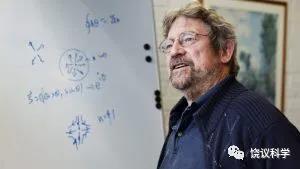
节选自《生物学概念与途径》第十章
PPT
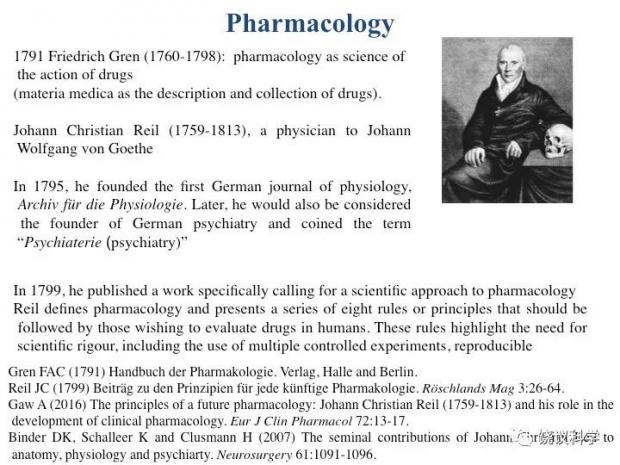

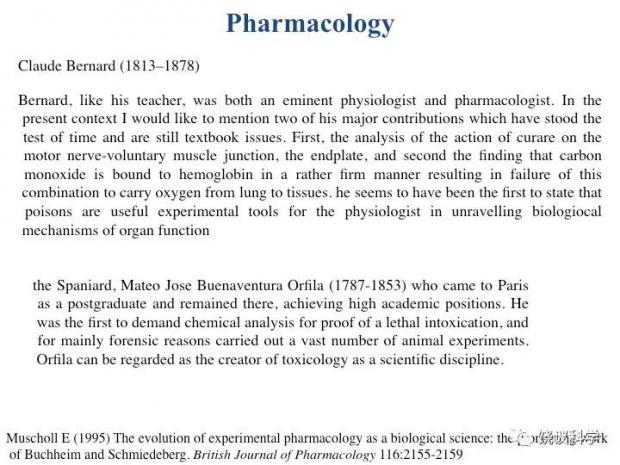
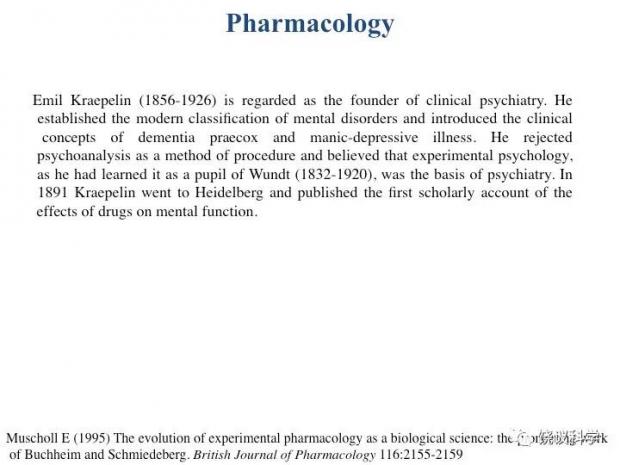
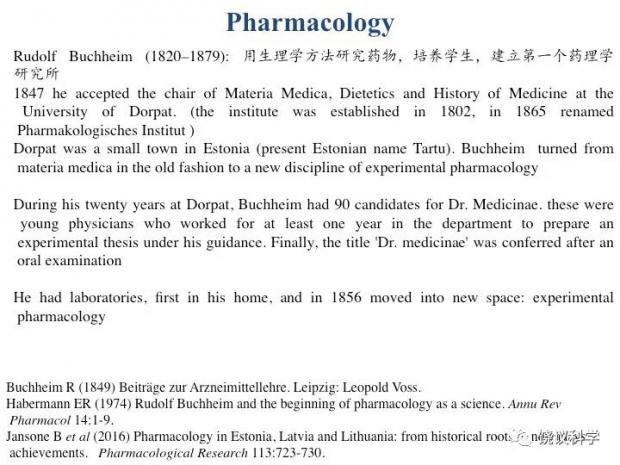
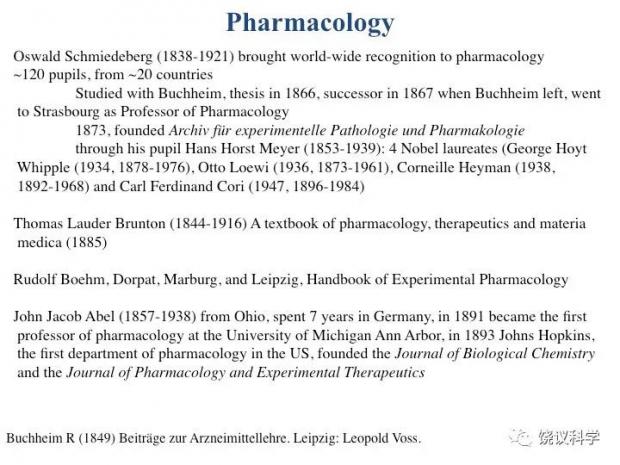
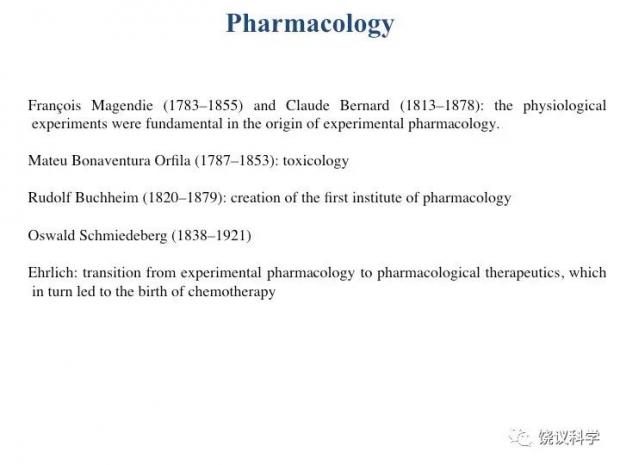
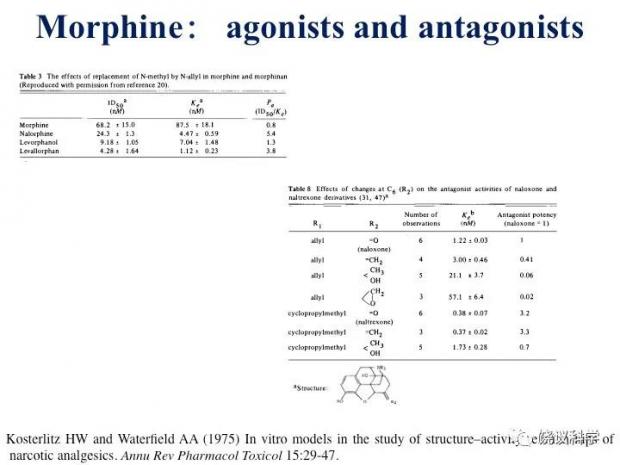
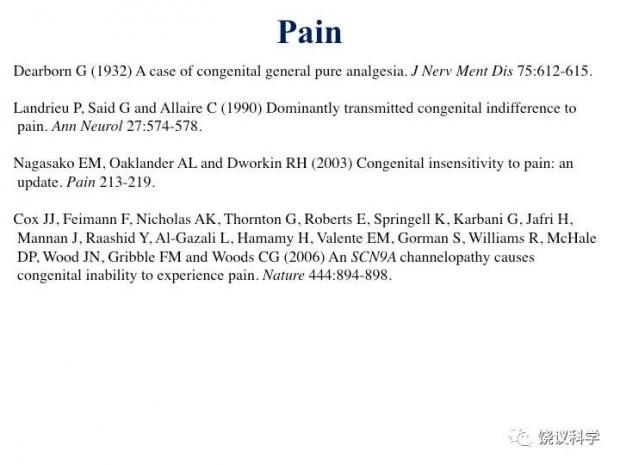
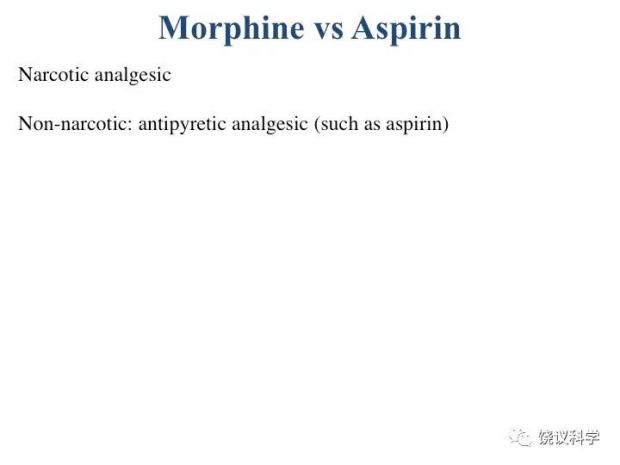

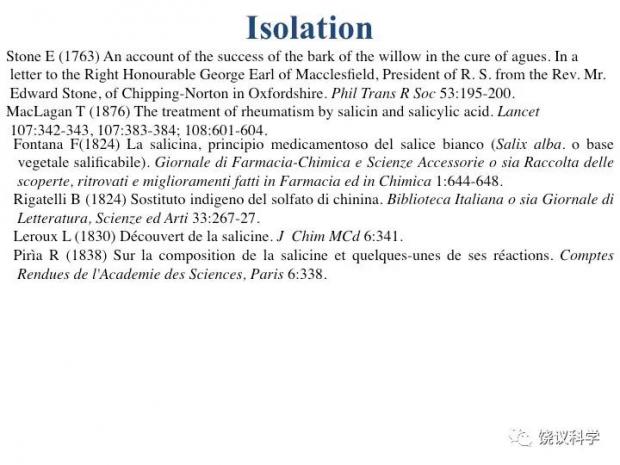
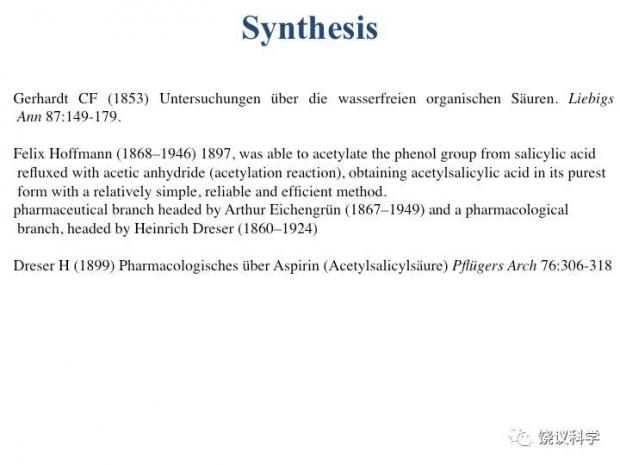
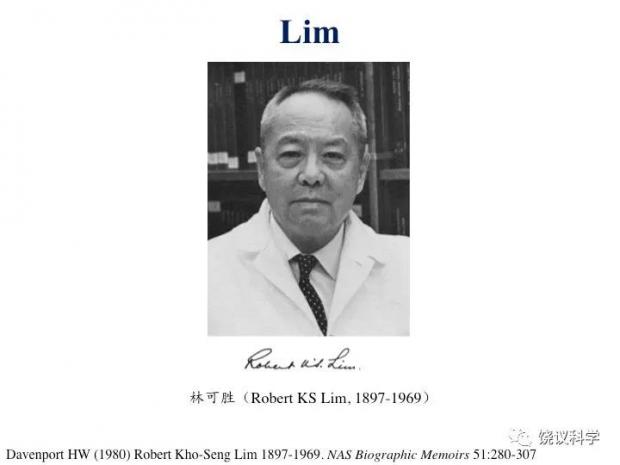
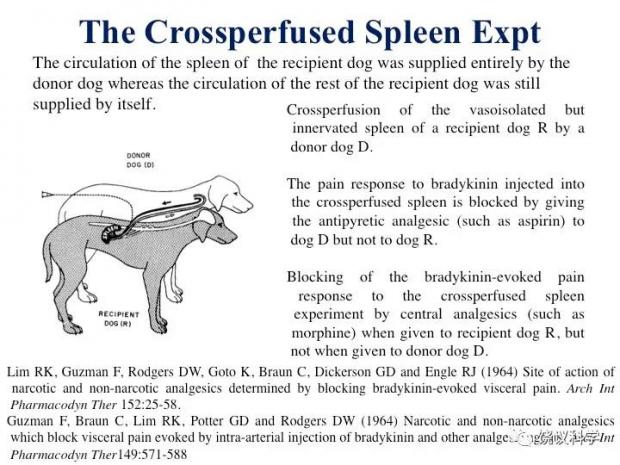
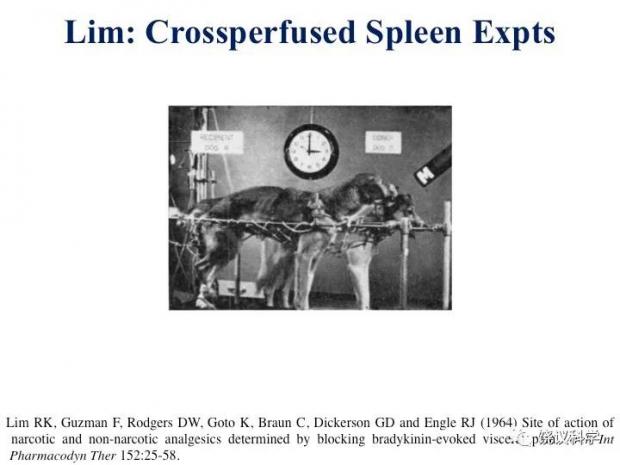
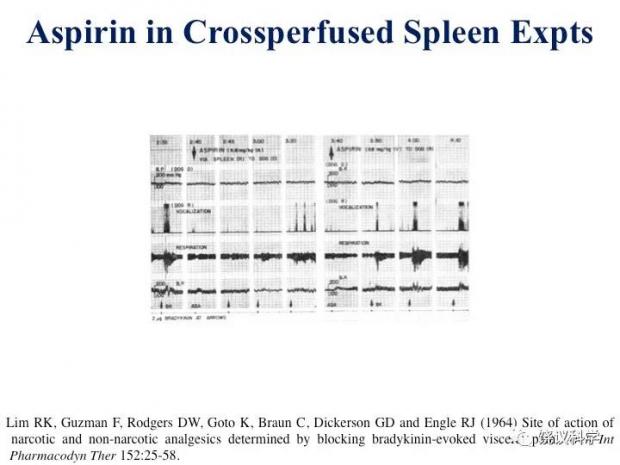


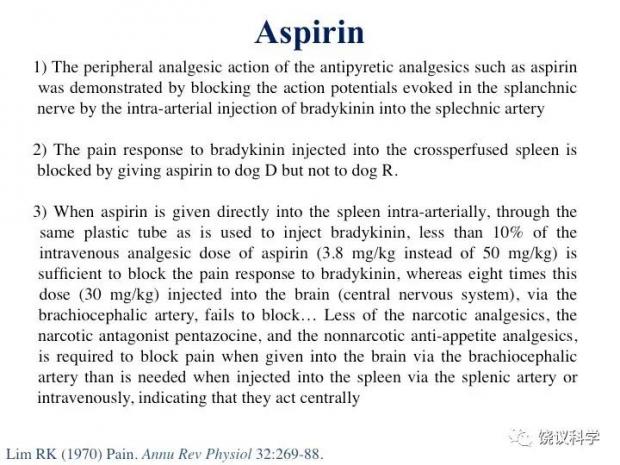
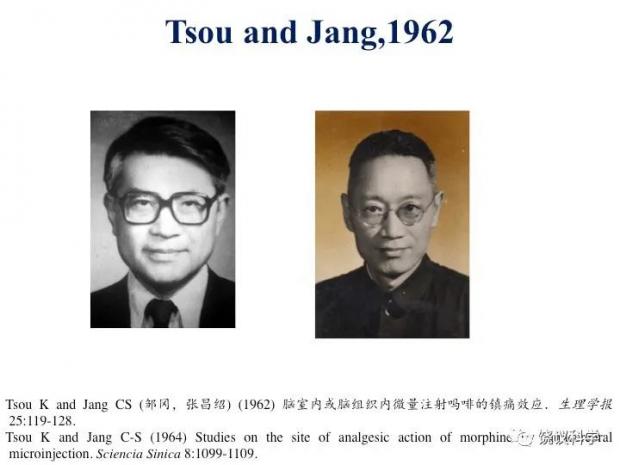
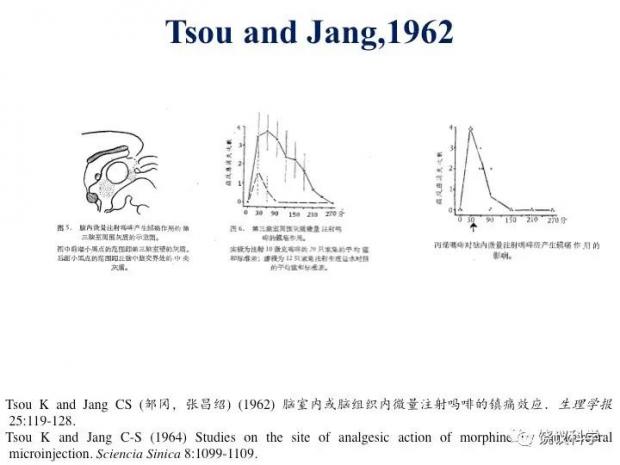

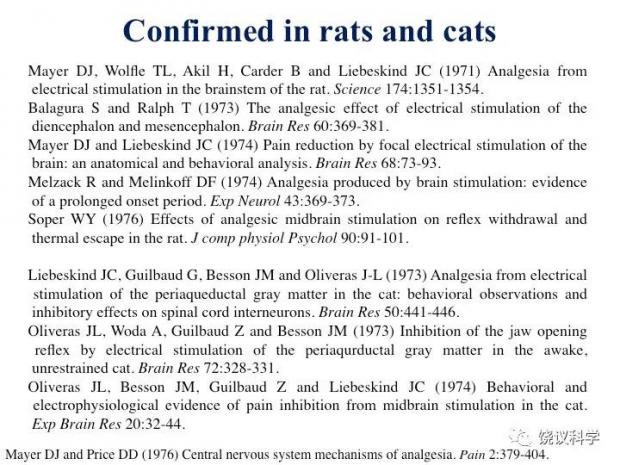


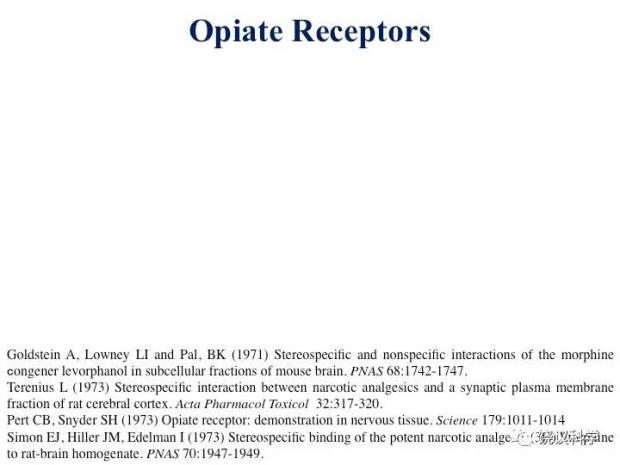
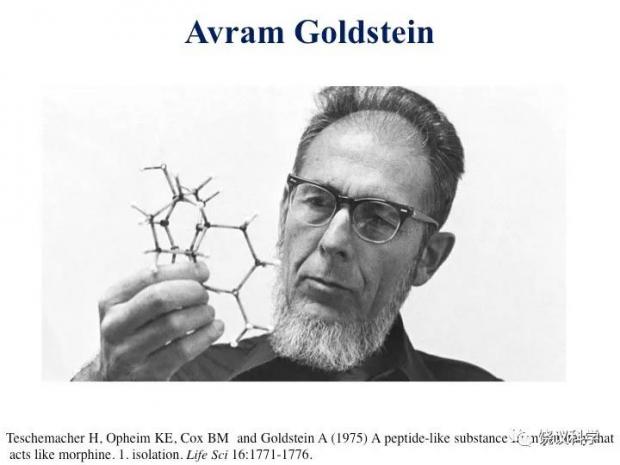
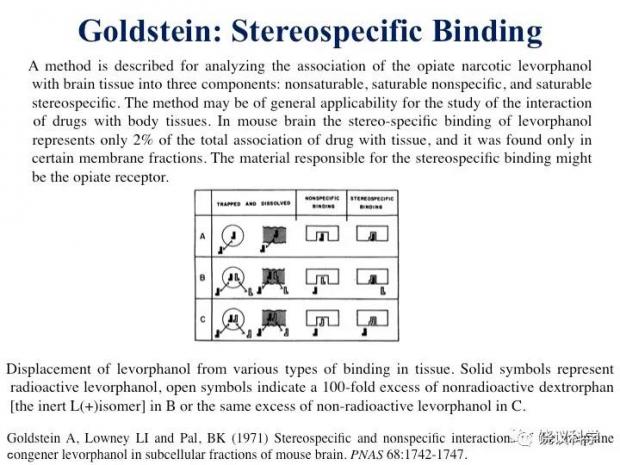
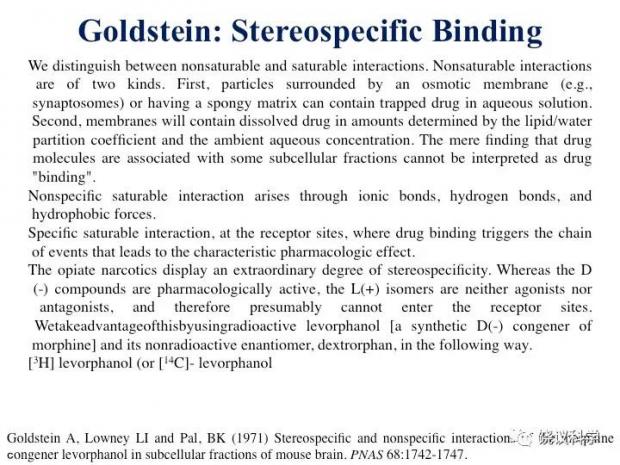
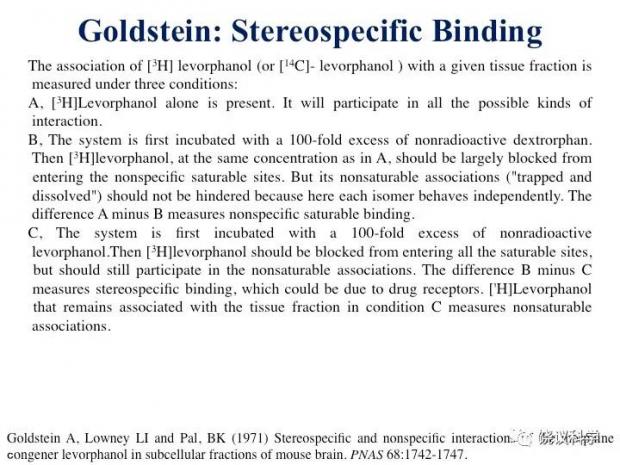
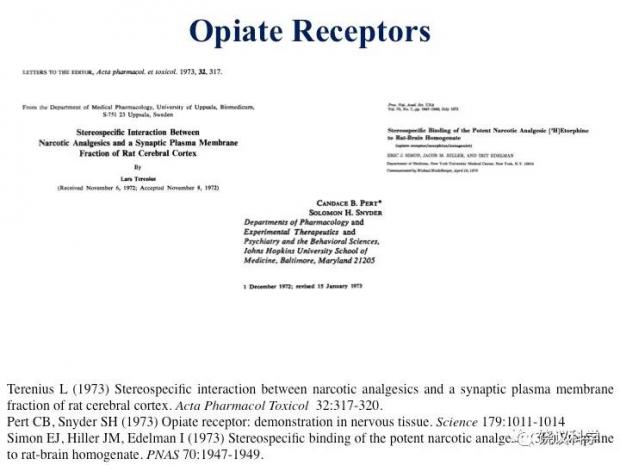
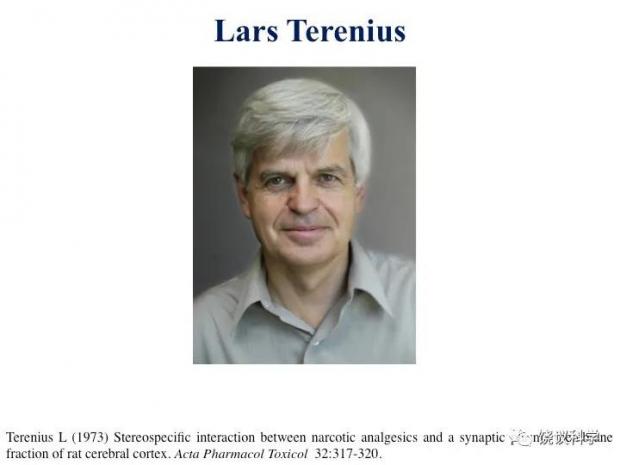
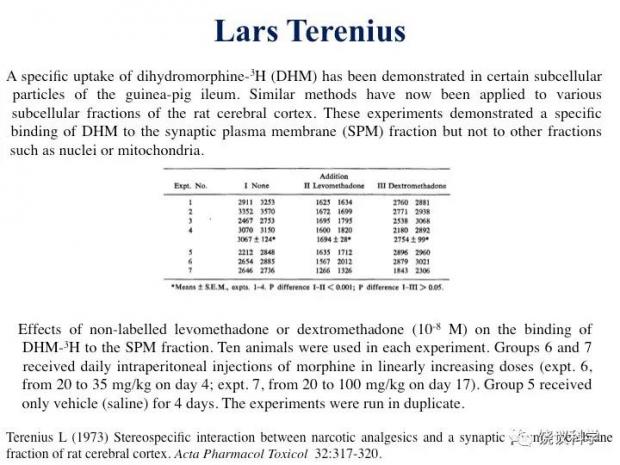
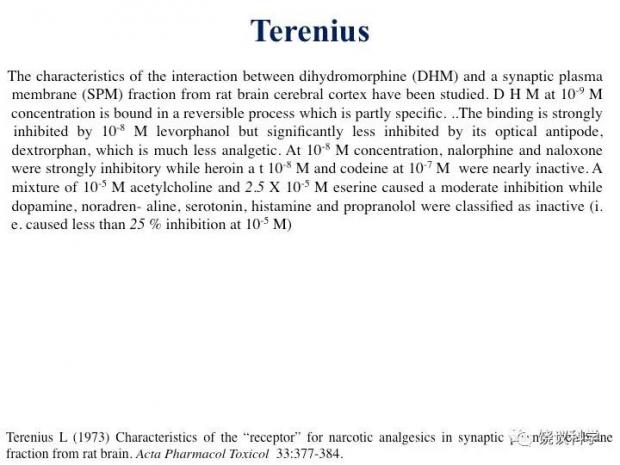


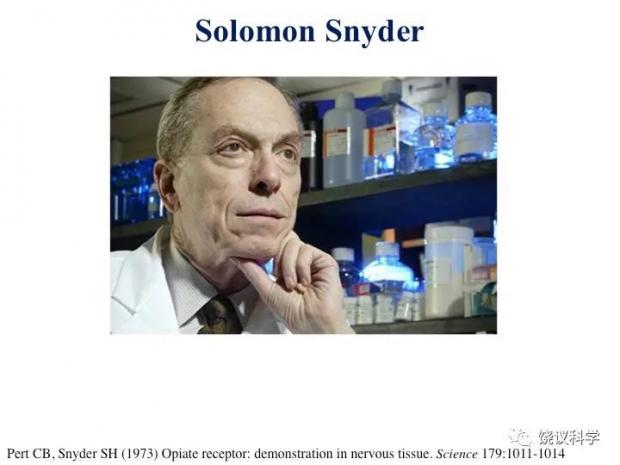
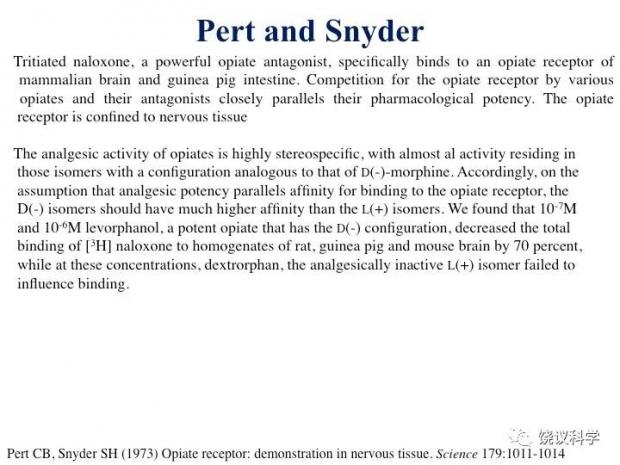
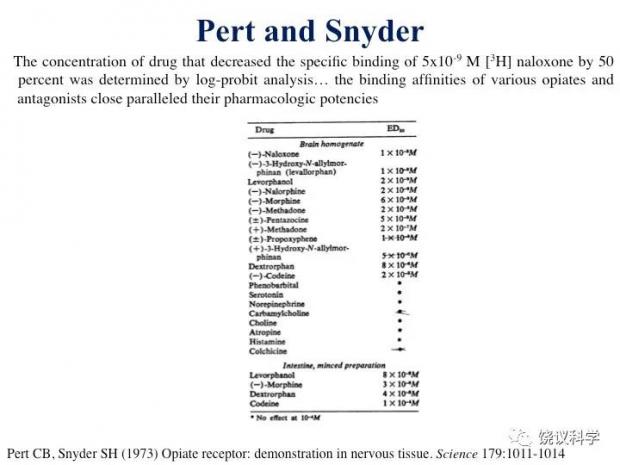


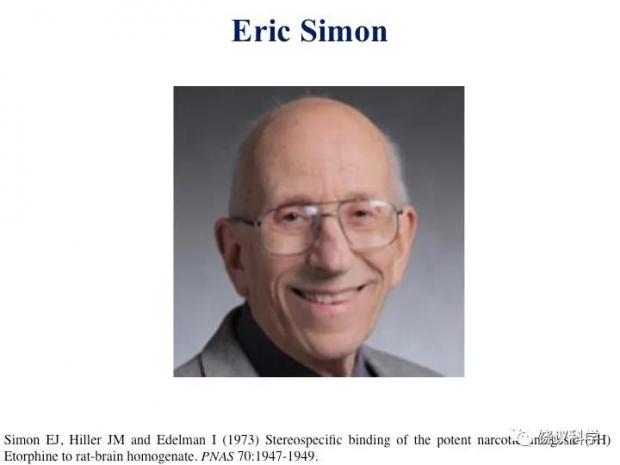
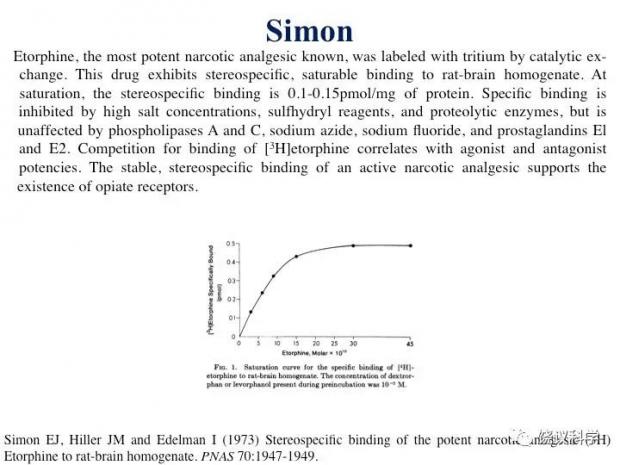
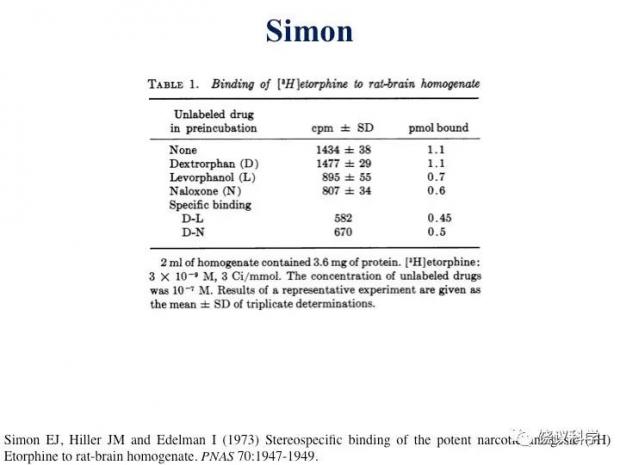

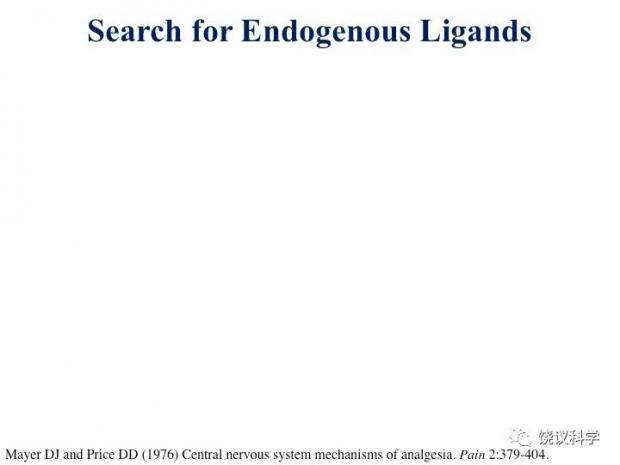
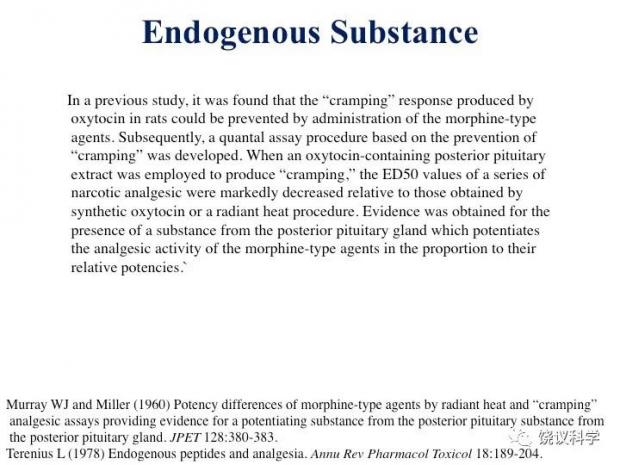
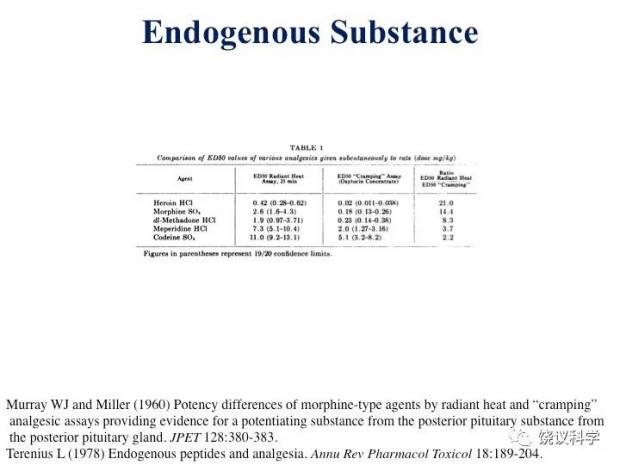
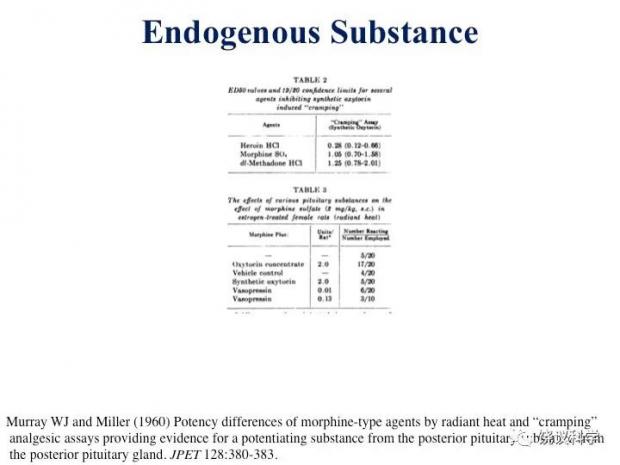
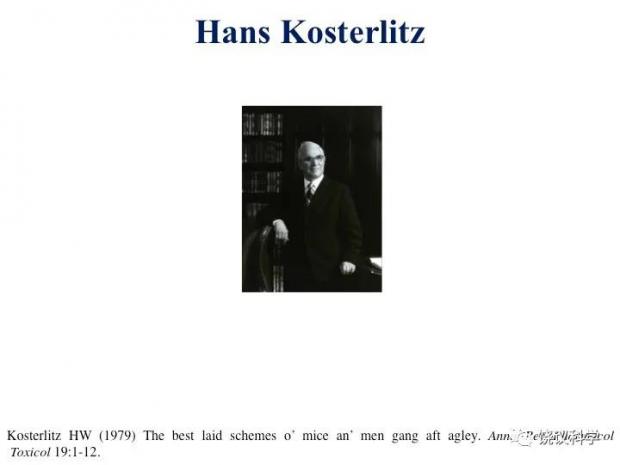
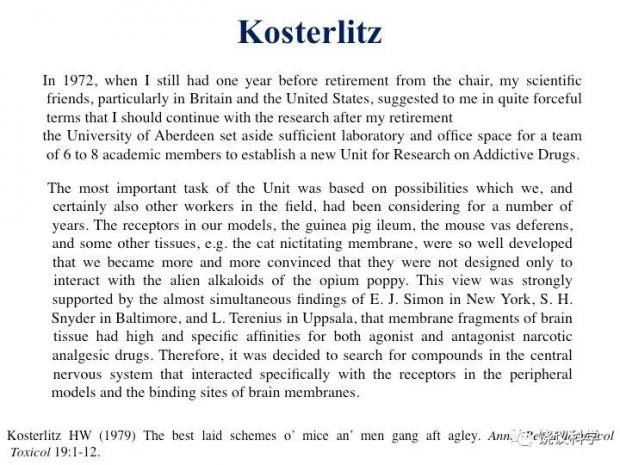
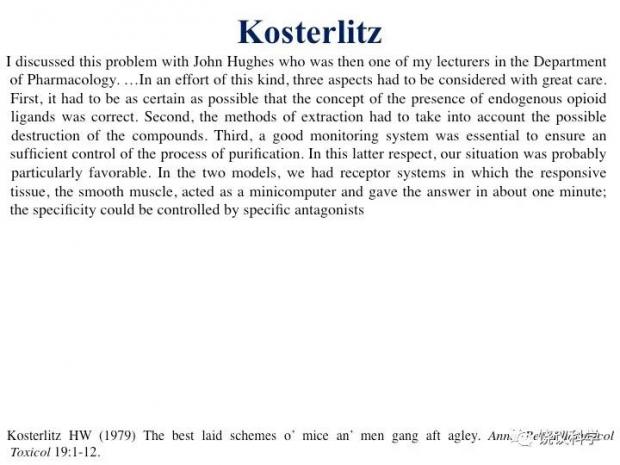
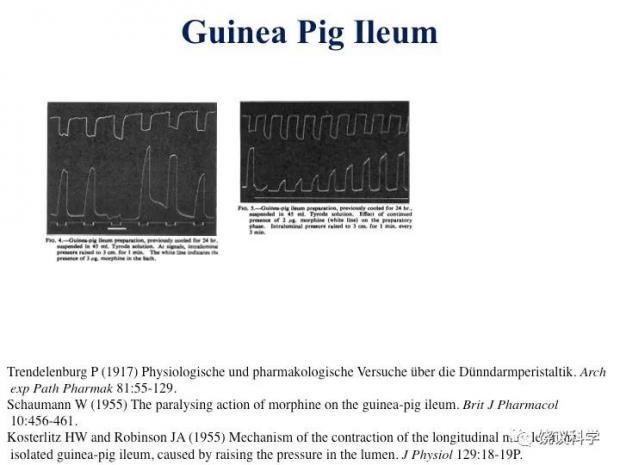
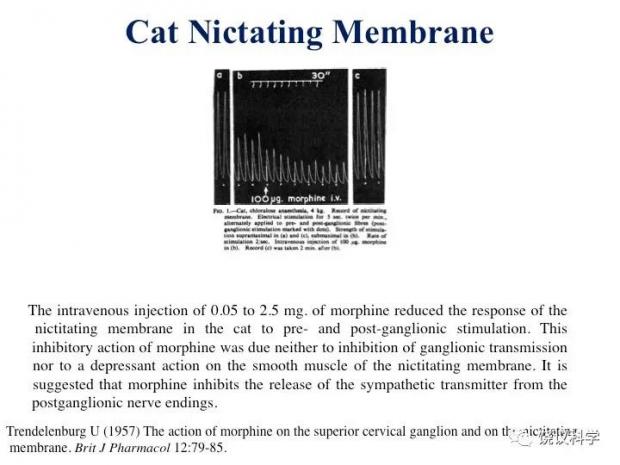
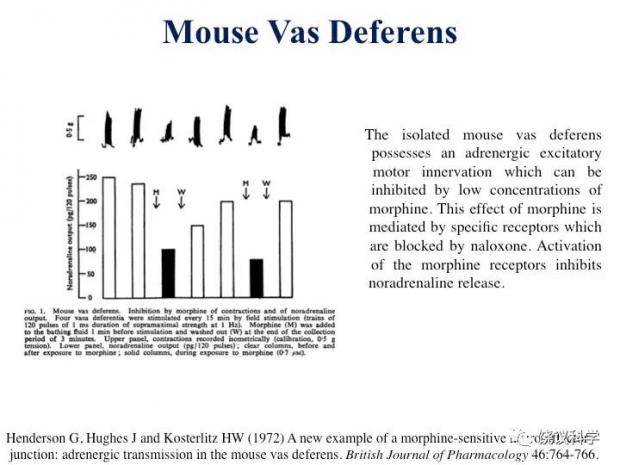
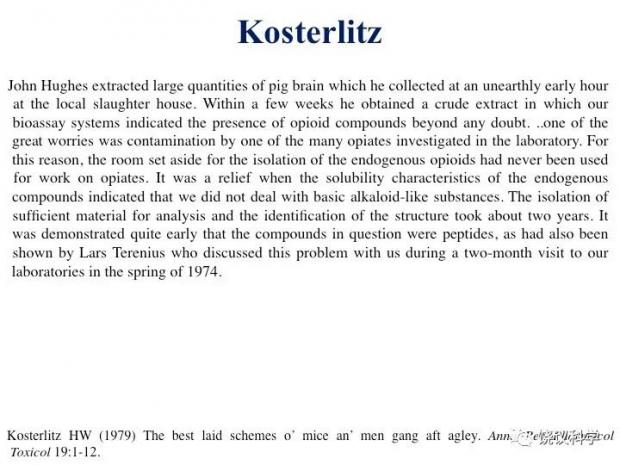
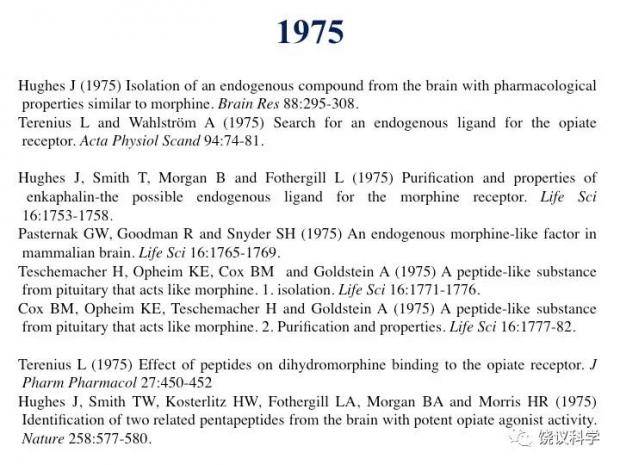
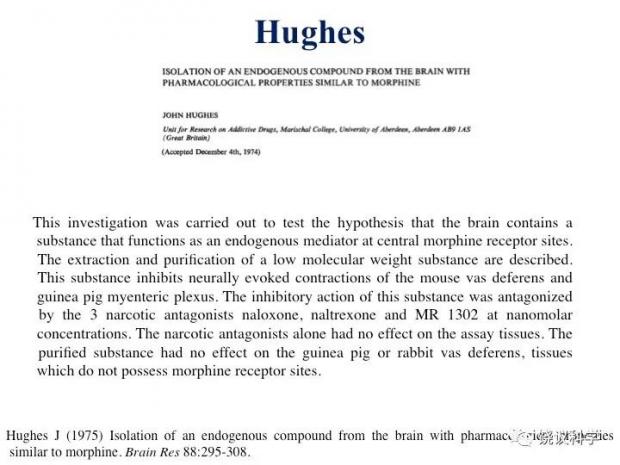
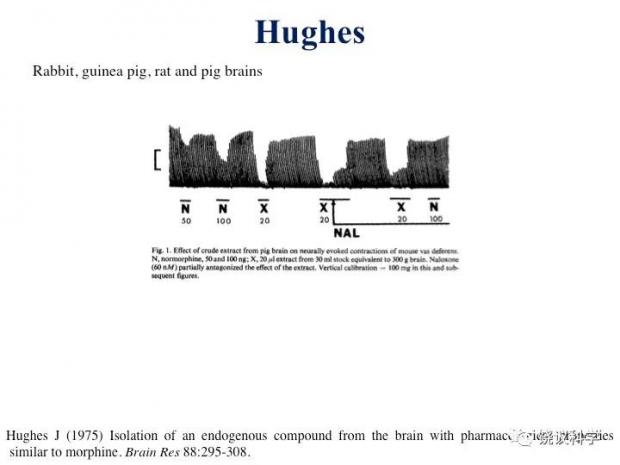
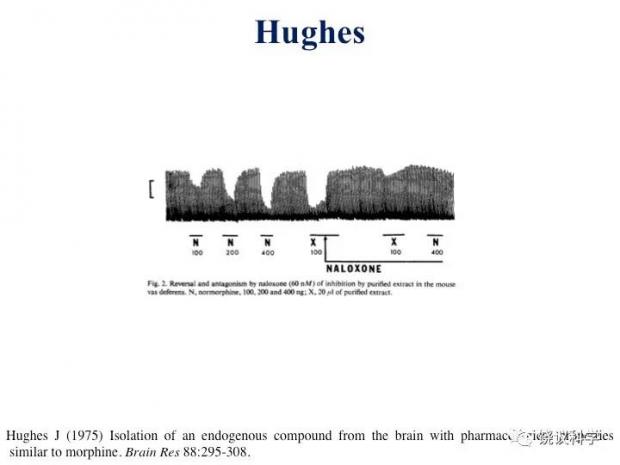
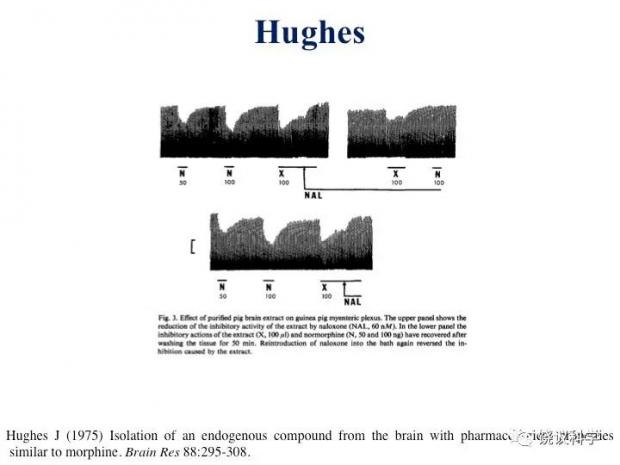
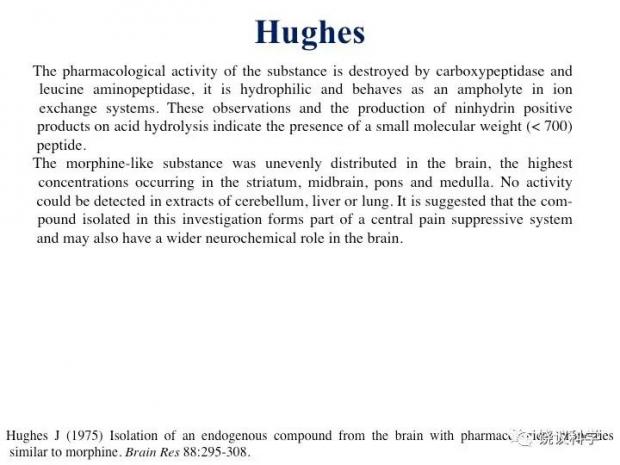
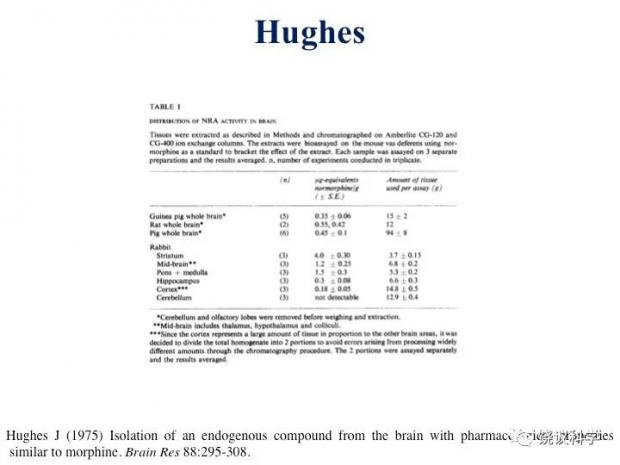
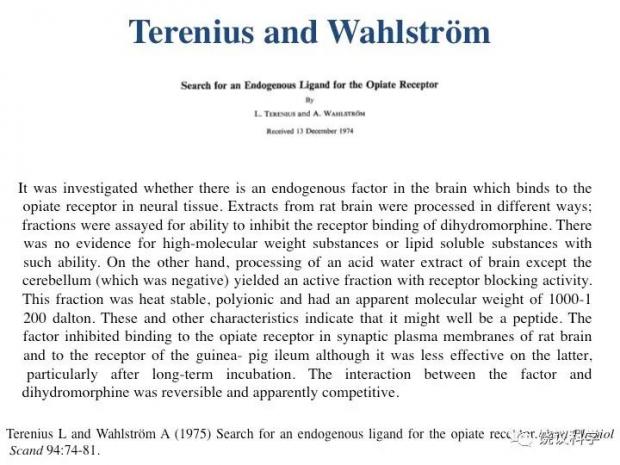
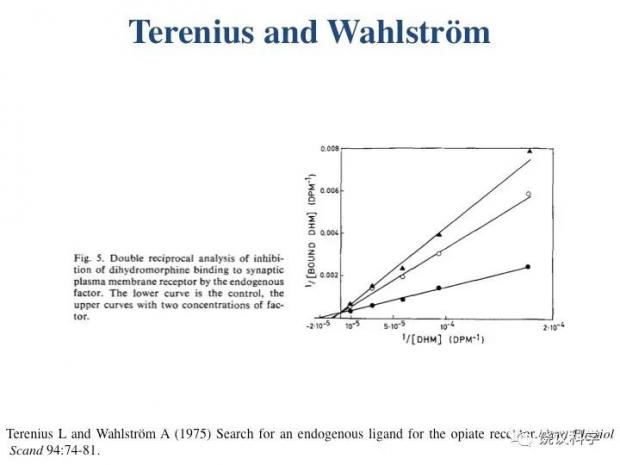
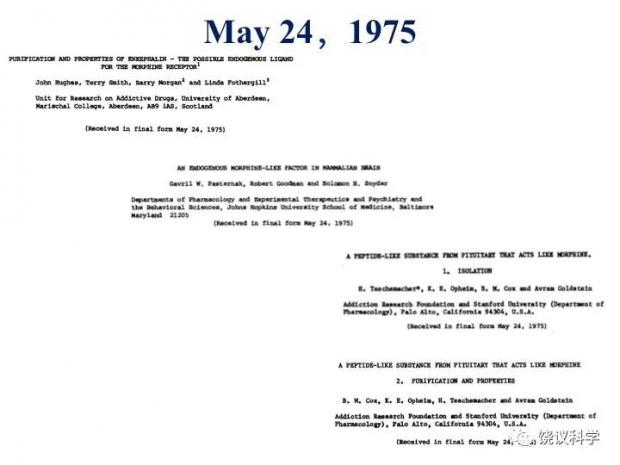
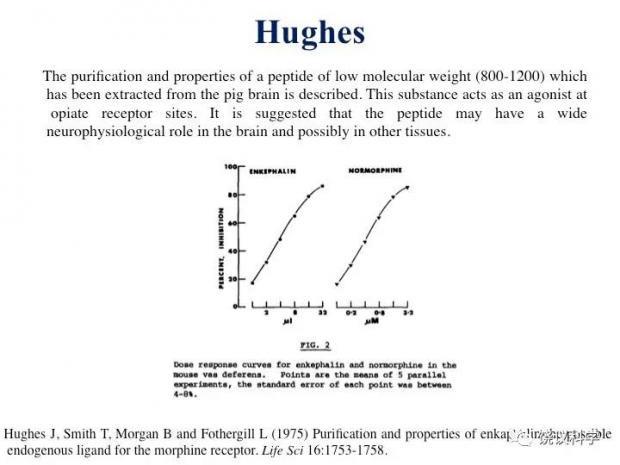
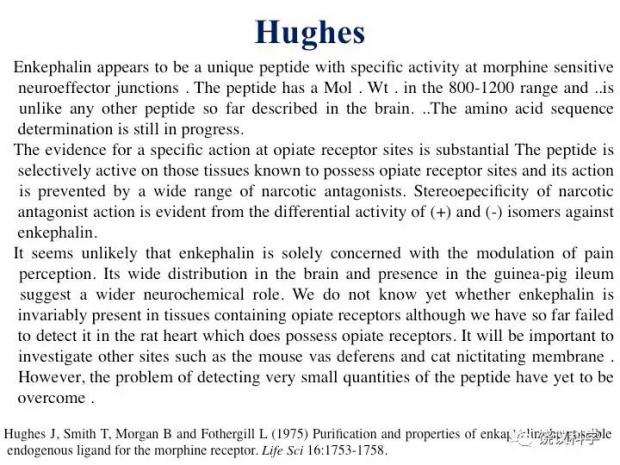
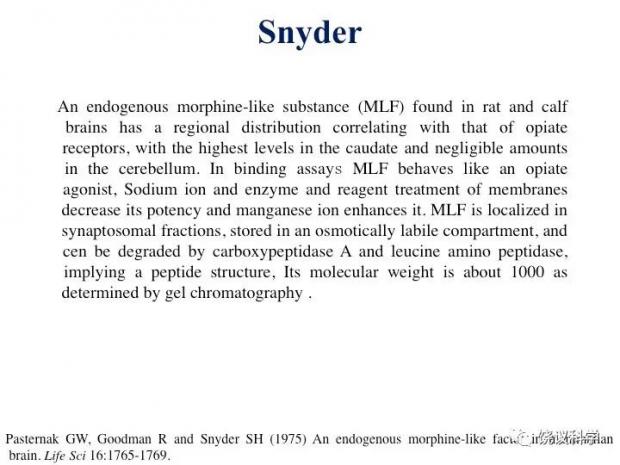
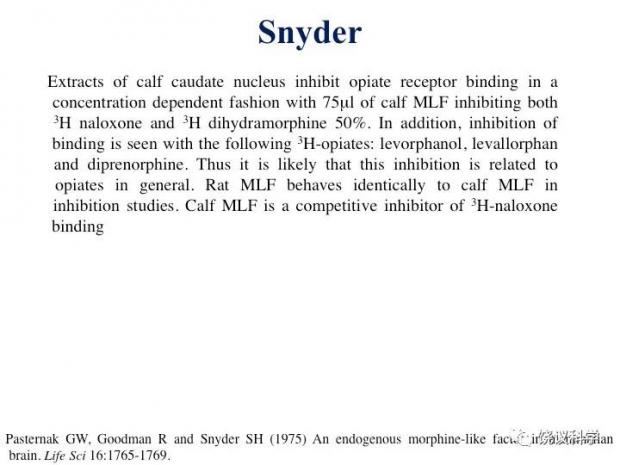
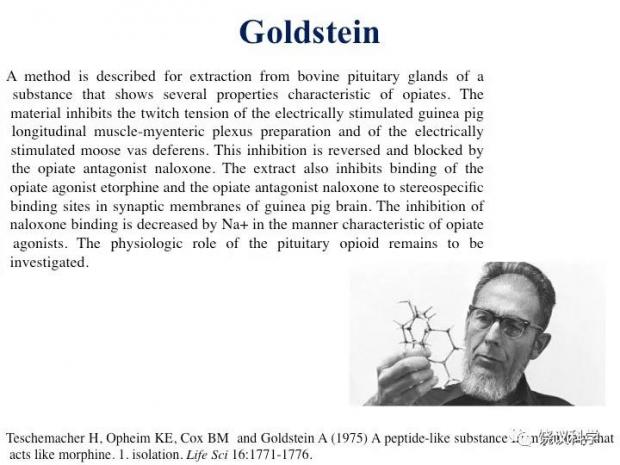
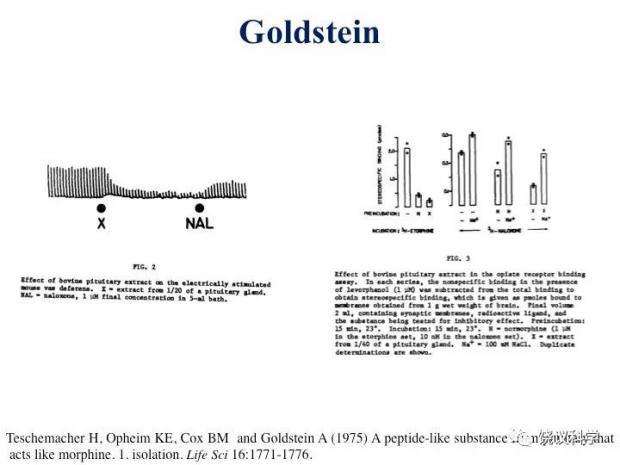
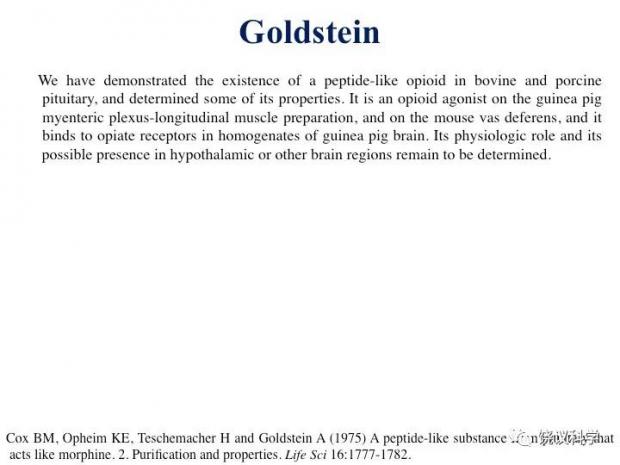


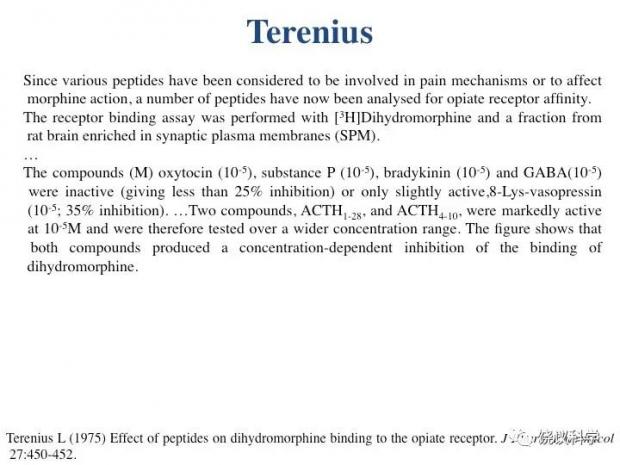
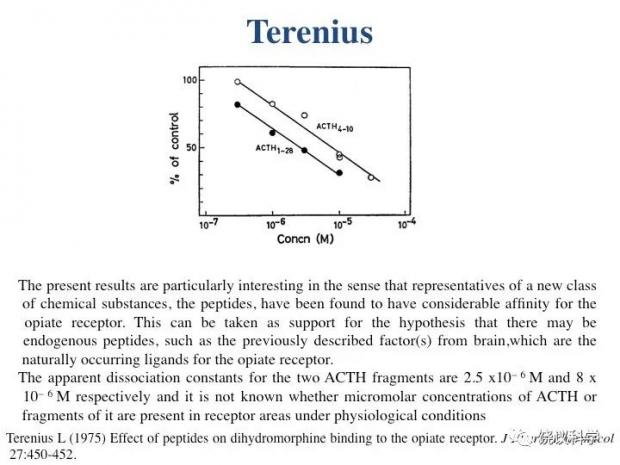
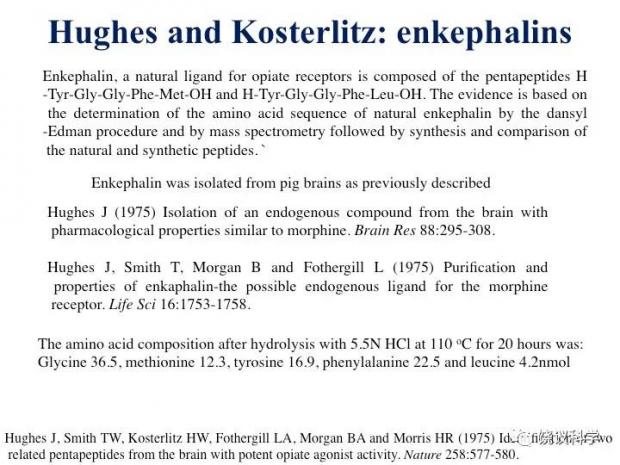
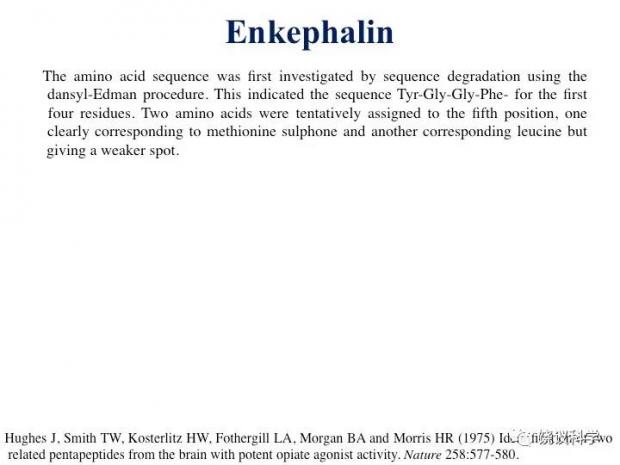

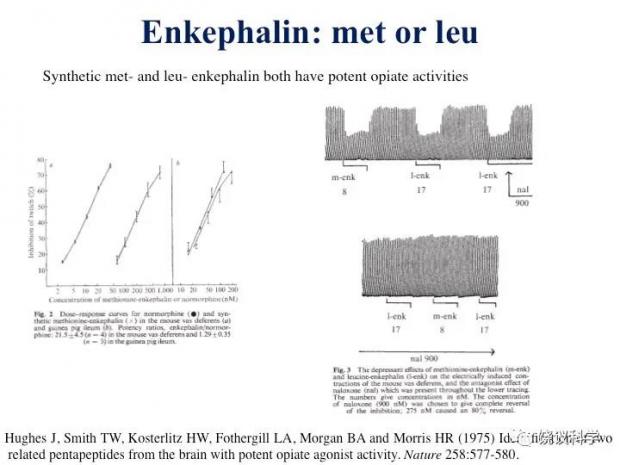
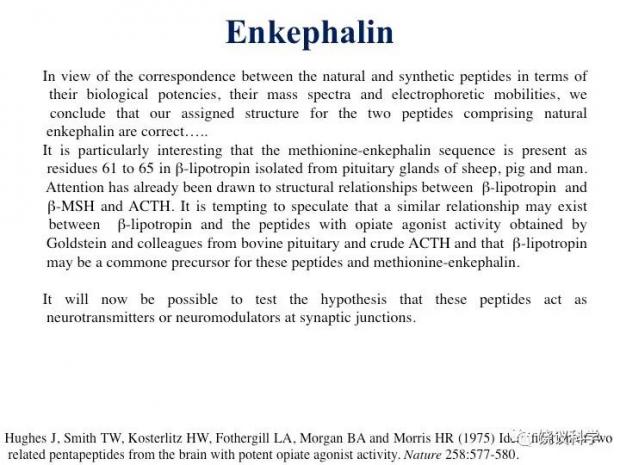
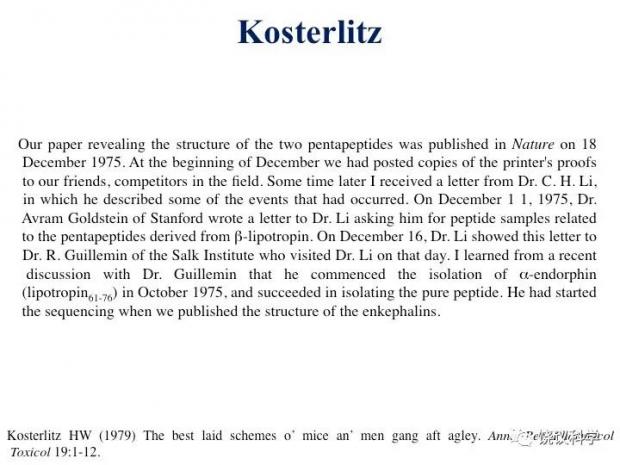
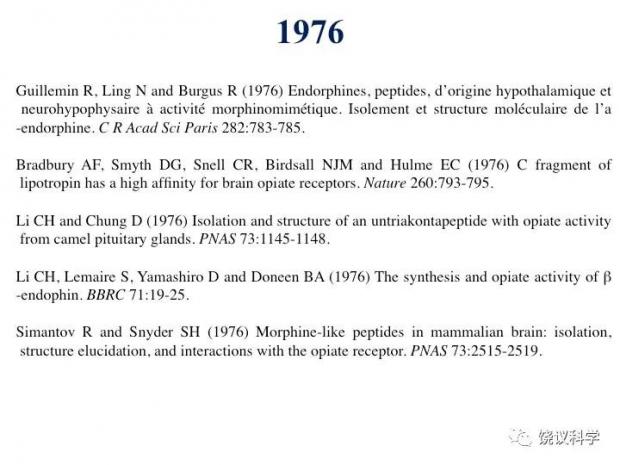
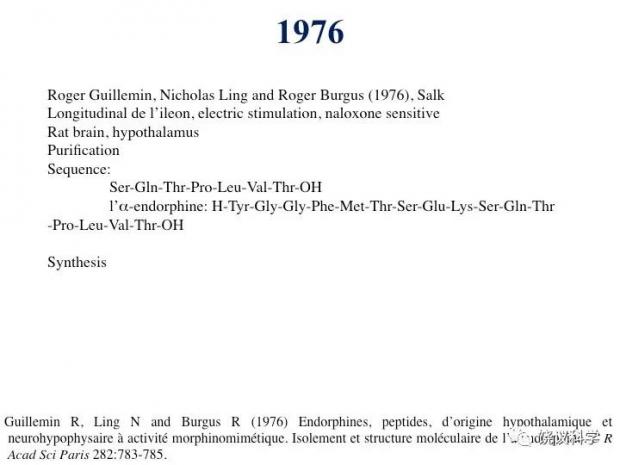
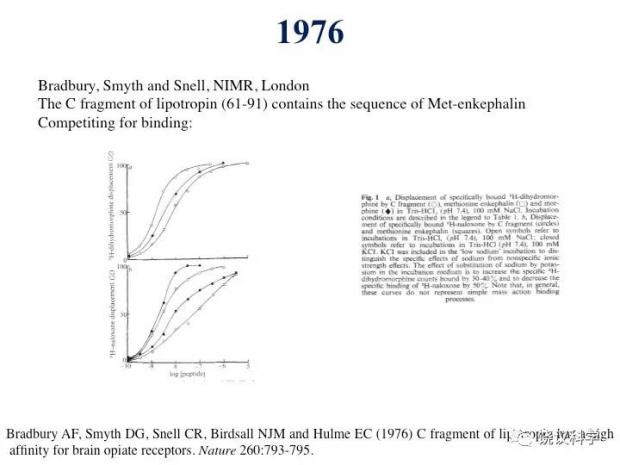
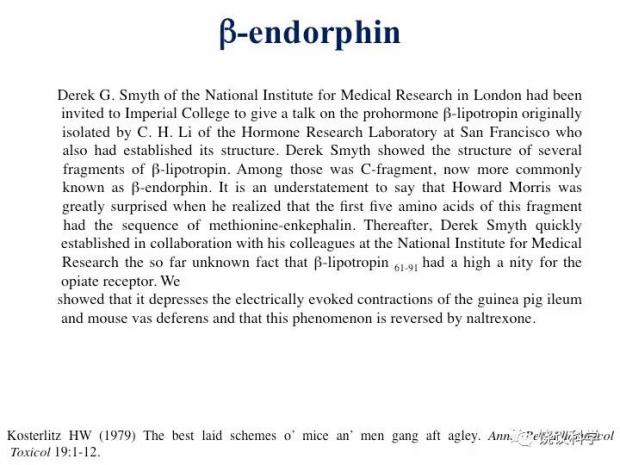
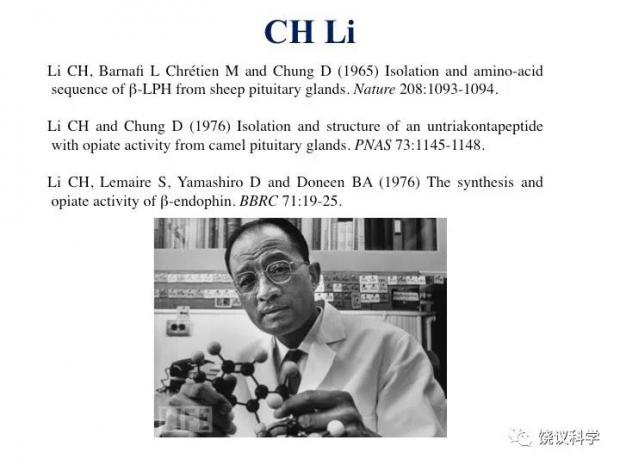
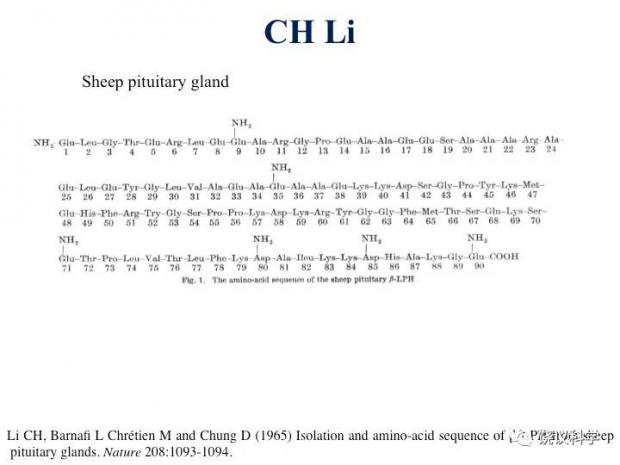
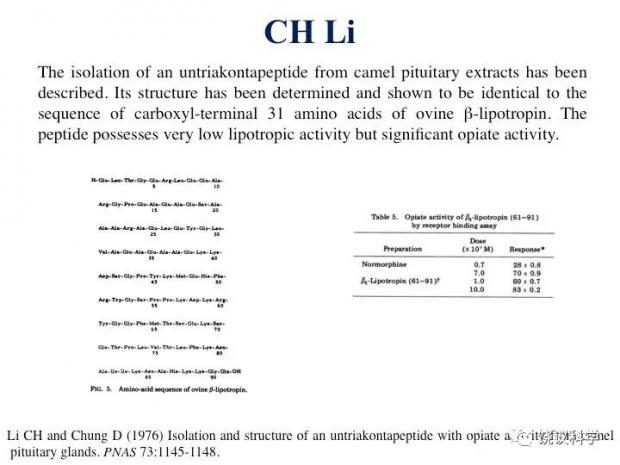
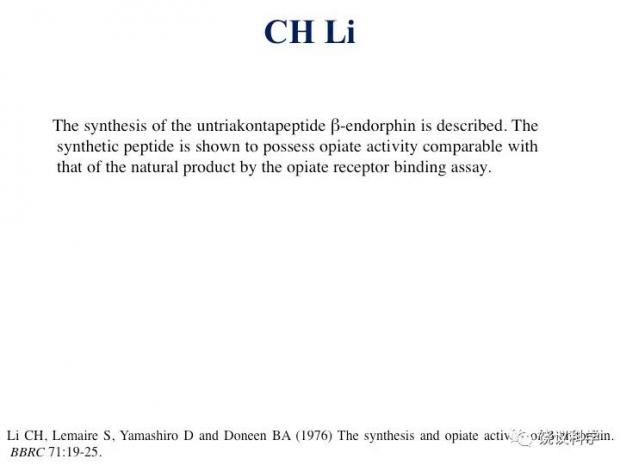
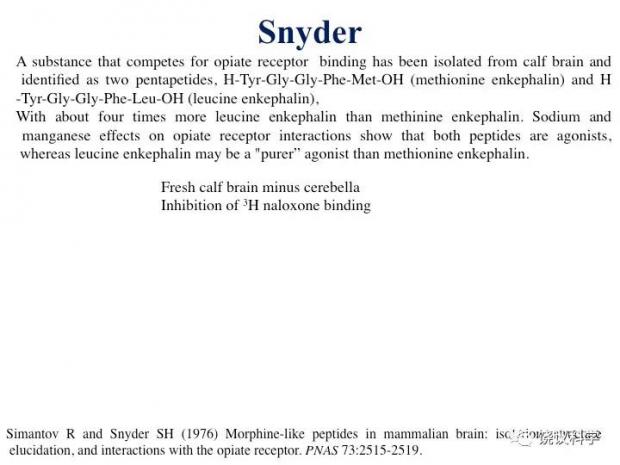
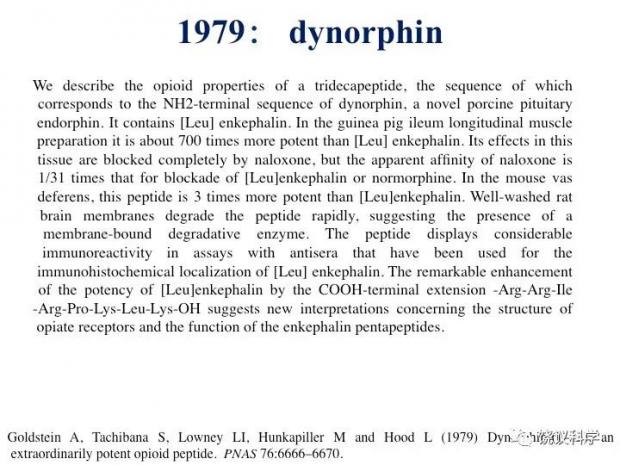
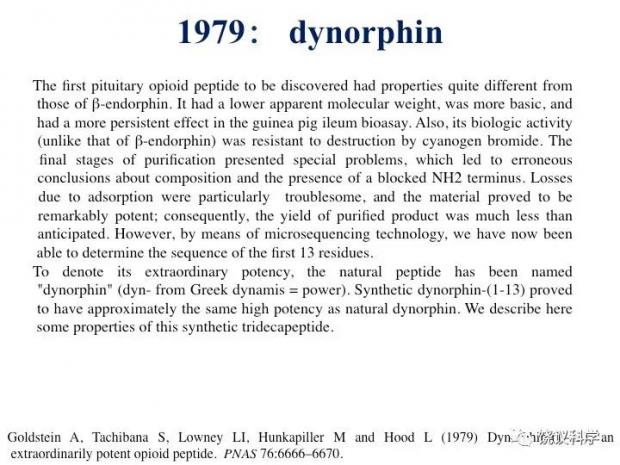
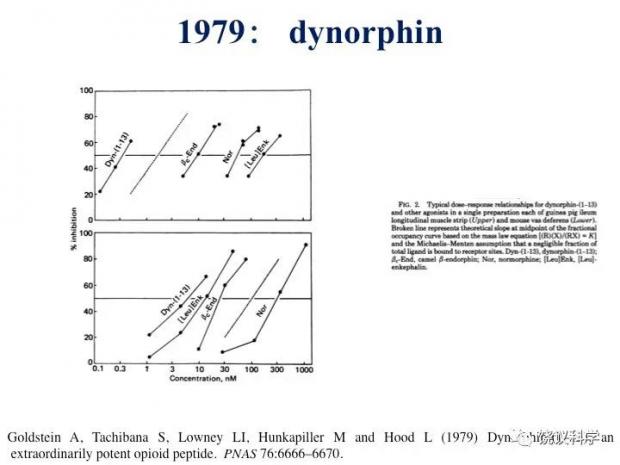
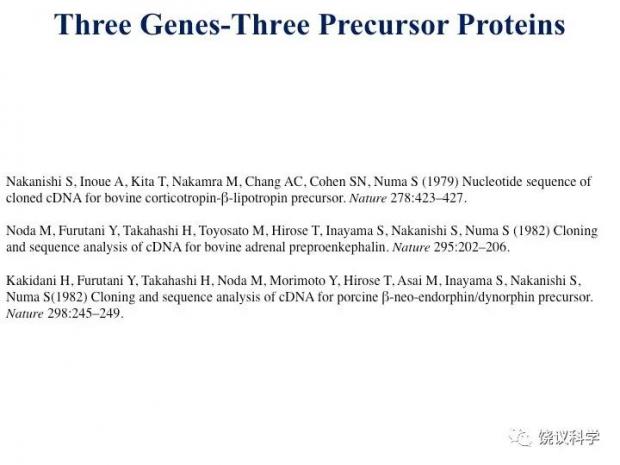

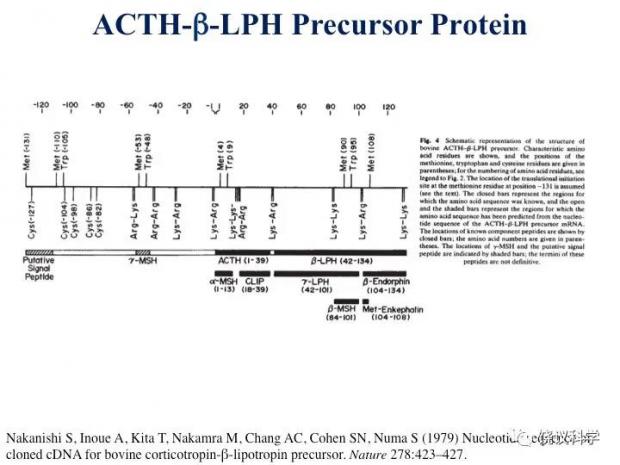
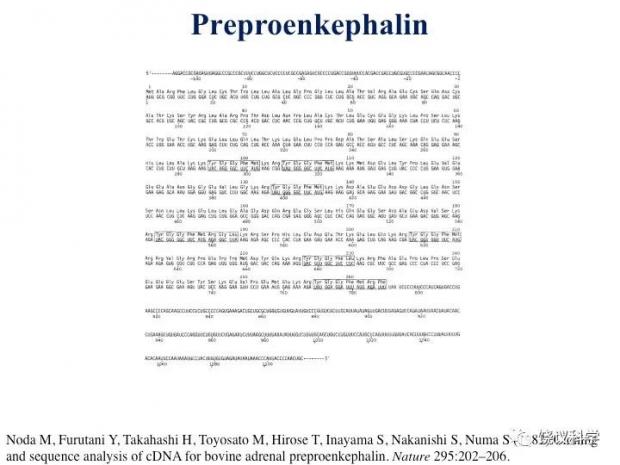
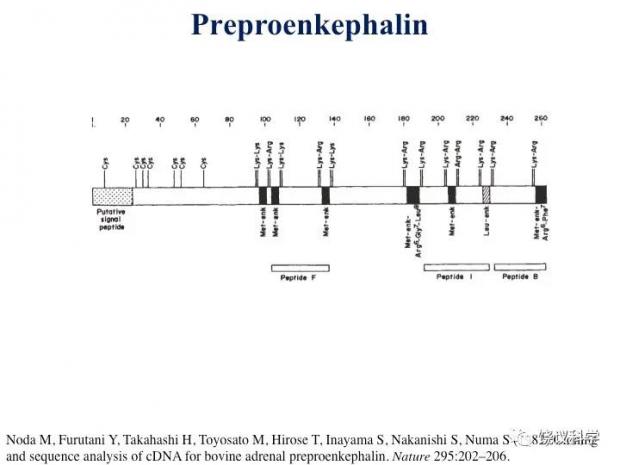
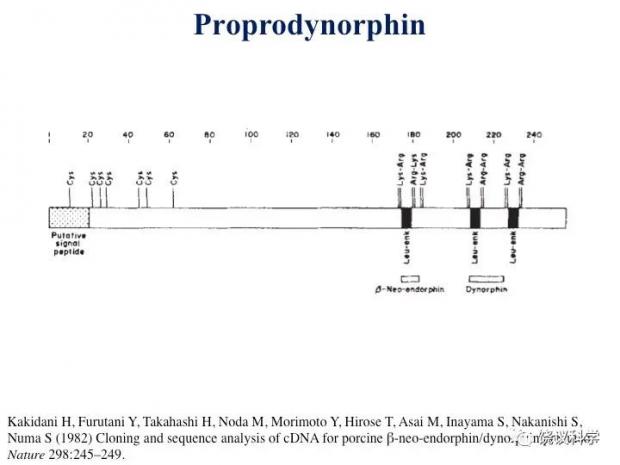
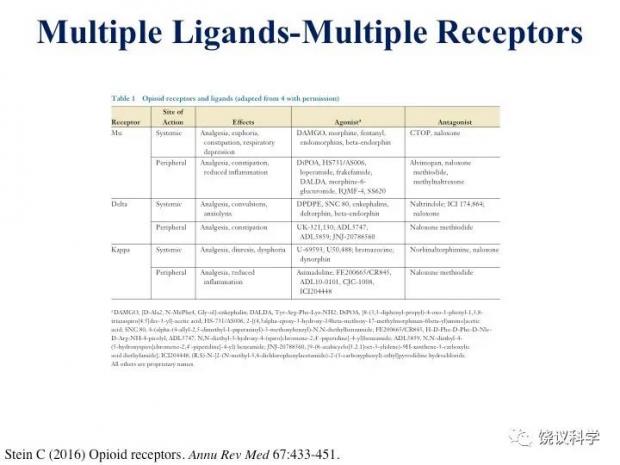
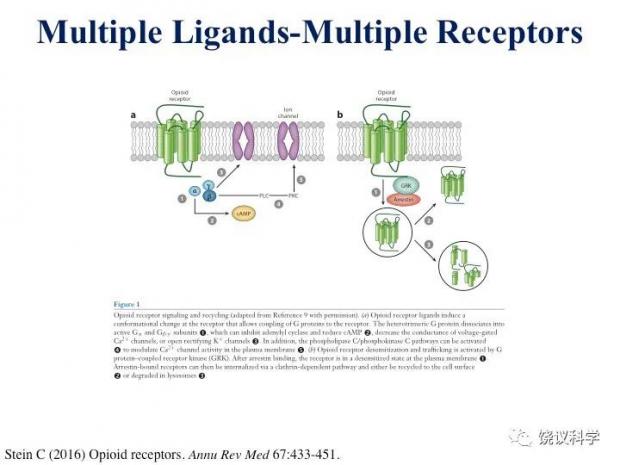
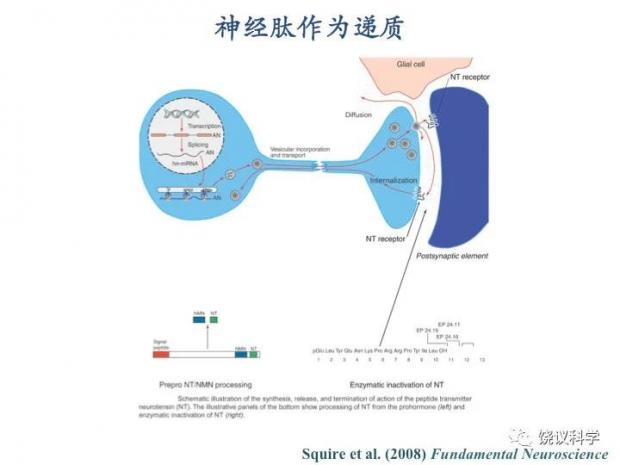
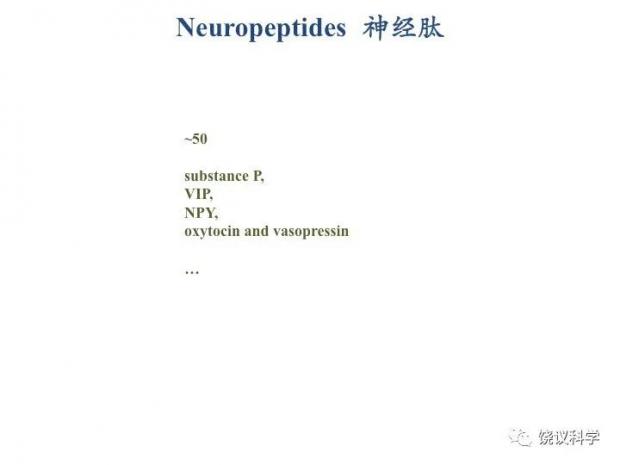
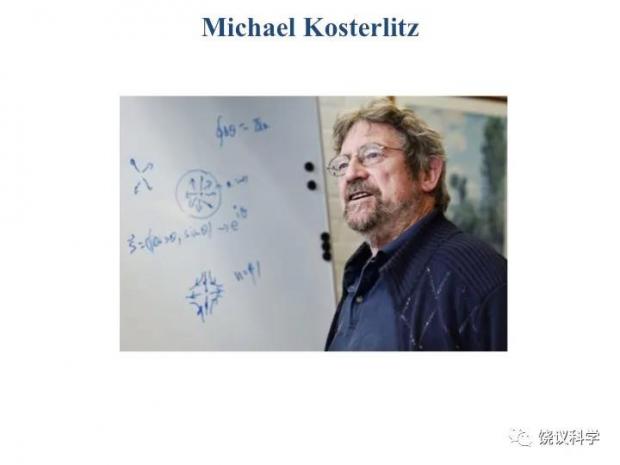
参考文献
Adams JE (1976) Naloxone reversal of analgesia produced by brain stimulation in the human. Pain 2:161-166.
Akil H, Maycr DJ and Liebeskind JC(1976 Antagonism of stimulation-produced analgesia by naloxone, a narcotic antagonist. Science 191:961-962.
Balagura S and Ralph T (1973) The analgesic effect of electrical stimulation of the diencephalon and mesencephalon. Brain Research 60:369-381.
Basbaum AI, Bautista DM, Scherrer G and Julius D (2009) Cellular and molecular mechanisms of pain. Cell 139:267-284.
Beckett AH (1952) Analgesics-a general survey. Journal of Pharmacy and Pharmacology4:425-447.
Beckett AH and Casy AF (1954) Synthetic analgesics: stereochemical considerations. Journal of Pharmacy and Pharmacology 6:986-1001.
Beckett AH, Casy AF and Harper (1956) Analgesics and their antagonists: some steric and chemical considerations: Part III. The influence of the basic group on the biological response. Journal of Pharmacy and Pharmacology 8:874-884.
Bentley KW and Cardwell HME (1955) The morphine-Thebaine group of alkaloids. Part V. The absolute stereochemistry of the morphine, benzylisoquinoline, aporphine, and tetrahydroberberine alkaloids. Journal of Chemical Society 3252-3260.
Blakemore PR and White JD (2002) Morphine, the Proteus of organic molecules. Chemical Communications 83:1159-1168.
Bradbury AF, Smyth DG, Snell CR, Birdsall NJM and Hulme EC (1976) C fragment of lipotropin has a high affinity for brain opiate receptors. Nature 260:793-795.
Chang MM and Leeman SE (1970) Isolation of a sialogogic peptide from bovine hypothalamic tissue and its characterization as substance P. Journal of Biological Chemistry 245:4784-4790.
Chang MM, Leeman SE and Niall HD (1971) Amino-acid sequence of substance P. Nature New Biology 232:86-87.
Chou CH and Hsu B (1959) The analgesic action of and the tolerance to morphine give intracerebrally in mice. Acta Physiologica Sinica 23:37-44.
Corbett AD, Paterson SJ, McKnight AT, Magnan J and Kosterlitz HW (1982) Dynorphin and dynorphin are ligands for the kappa-subtype of opiate receptor. Nature 299:79-81.
Cox BM, Opheim KE, Teschemacher H and Goldstein A (1975) A peptide-like substance from pituitary that acts like morphine. 2. Purification and properties. Life Sciences 16:1777-1782.
Cox JJ, Feimann F, Nicholas AK, Thornton G, Roberts E, Springell K, Karbani G, Jafri H, Mannan J, Raashid Y, Al-Gazali L, Hamamy H, Valente EM, Gorman S, Williams R, McHale DP, Wood JN, Gribble FM and Woods CG (2006) An SCN9A channelopathy causes congenital inability to experience pain. Nature 444:894-898.
Dearborn G (1932) A case of congenital general pure analgesia. Journal of Nervous and Mental Diseases 75:612-615.
Derosne CL (1803) Mémoires sur l’opium. Annales de chimie 45:257-285.
Domagk G (1935) Ein Beiträg zür Chemotherapie der bakteriellen Infektionen. Deutsche medizinische Wochenschrift 61:250-253.
Dreser H (1899) Pharmacologisches über Aspirin (Acetylsalicylsäure) Pflügers Archiv für die gesamte Physiologie 76:306-318.
Euler USv and Gaddum JH (1931) An unidentified depressor substance in certain tissue extracts. Journal of Physiology 72:74-87.
Finlay AC, Hobby GL, P’an SY, Regna PP, Routien JB, Seeley DB, Shull GM, Sobin BA, Solomons IA, Vinson JW and Kane JH (1950) Terramycin, a new antibiotic. Science 111:85.
Gates M and Tschudi G (1952) The synthesis of morphine. Journal of the American Chemical Society 74:1109-1110.
Gates M and Tschudi G (1956) The synthesis of morphine Journal of the American Chemical Society 78:1380-1393.
Goldstein A, Lowney LI and Pal BK (1971) Stereospecific and nonspecific interactions of the morphine congener levorphanol in subcellular fractions of mouse brain. Proceedings of the National Academy of Sciences USA 68:1742-1747.
Goldstein A, Tachibana S, Lowney LI, Hunkapiller M and Hood L (1979) Dynorphin-(1–13), an extraordinarily potent opioid peptide. Proceedings of the National Academy of Sciences USA 76:6666–6670.
Goldstein A, Fischli W, Lowney LI, Hunkapiller M and Hood L (1981) Porcine pituitary dynorphin: complete amino acid sequence of the biologically active hep- tadecapeptide. Proceedings of the National Academy of Sciences USA78:7219-23.
Goodman SJ and Holcombe V (1976) Selective and prolonged analgesia in monkey resulting from brain stimulation. In: Advances in Pain Research and Therapy, edited by Bonica JJ and Albe-Fesard D, New York: Raven, 1:495-502.
Guillemin R, Ling N and Burgus R (1976) Endorphines, peptides, d’origine hypothalamique et neurohypophysaire à activité morphinomimétique. Isolement et structure moléculaire de l’a-endorphine. Comptes Rendus de l’Académie des Sciences Paris 282:783-785.
Gulland JM and Robinson R (1923) The morphine group. Part I. A discussion of the constitutional problem. Journal of Chemical Society 123:980-998.
Gulland JM and Robinson R (1925) Constitution of codeine and thebaine. Memoirs and Proceedings of the Literary and Philosophical Society of Manchester 69:79-86.
Guzman F, Braun C, Lim RK, Potter GD and Rodgers DW (1964) Narcotic and non-narcotic analgesics which block visceral pain evoked by intra-arterial injection of bradykinin and other analgesic agents. Archives Internationales de Pharmacodynamie et de Thérapie 149:571-588.
Hayes RL, Price DD Ruda M and Dubner R (1979) Suppression of nociceptive responses in the primate by electrical stimulation of the brain or morphine administration: Behavioral and electrophysiological comparisons. Brain Research 167:417-421.
Henderson G, Hughes J and Kosterlitz HW (1972) A new example of a morphine-sensitive neuro-effector junction: adrenergic transmission in the mouse vas deferens. British Journal of Pharmacology 46:764-766.
Hosobuchi Y, Adams JE and Linchitz R (1977) Pain relief by electrical stimulation of the central gray matter in humans and its reversal by 197:183-186.
Holmes HL (1952) The morphine alkaloids. I. The Alkaloids: Chemistry and Physiology 2:1-159 Vol III, Chapter 8, Part 1. Academic Press, London.
Holmes HL and Stork G (1952) The morphine alkaloids. In: Manske RHF, Holmes HL (eds) The alkaloids, Vol III, Chapter 8, Part 2. Academic Press, London.
Hughes J (1975) Isolation of an endogenous compound from the brain with pharmacological properties similar to morphine. Brain Research 88:295-308.
Hughes J, Smith T, Morgan B and Fothergill L (1975) Purification and properties of enkaphalin-the possible endogenous ligand for the morphine receptor. Life Sciences 16:1753-1758.
Hughes J, Smith TW, Kosterlitz HW, Fothergill LA, Morgan BA and Morris HR (1975) Identification of two related pentapeptides from the brain with potent opiate agonist activity. Nature 258:577-580.
Hughes J, Kosterlitz HW and Leslie FM (1975) Effect of morphine on adrenergic transmission in the mouse vas deferens. Assessment of agonist and antogonist potencies of narcotic analgesics. British Journal of Pharmacology 53:371-381.
Jones J (1700) The mysteries of opium reveal’d. Richard Smith, Angel and Bible, London ().
Kakidani H, Furutani Y, Takahashi H, Noda M, Morimoto Y, Hirose T, Asai M, Inayama S, Nakanishi S and Numa S (1982) Cloning and sequence analysis of cDNA for porcine β-neo-endorphin/dynorphin precursor. Nature 298:245-249.
Kosterlitz HW (1979) The best laid schemes o’ mice an’ men gang aft agley. Annual Review of Pharmacology and Toxicology 19:1-12.
Kosterlitz HW and Robinson JA (1955) Mechanism of the contraction of the longitudinal muscle of the isolated guinea-pig ileum, caused by raising the pressure in the lumen. Journal of Physiology 129:18-19P.
Kosterlitz HW and Wallis DI (1966) The effects of hexamethonium and morphine on transmission in the superior cervical ganglion of the rabbit. British Journal of Phavmacology 26:334-344.
Kosterlitz HW and Waterfield AA (1975) In vitro models in the study of structure–activity relationships of narcotic analgesics. Annual Review of Pharmacology 15:29-47.
Kosterlitz HW and Watt AJ (1968) Kinetic parameters of narcotic agonists and antagonists, with particular reference to N-allylnoroxymorphone (naloxone). British Journal of Pharmacology and Chemotherapeutics 33:266–276.
Landrieu P, Said G and Allaire C (1990) Dominantly transmitted congenital indifference to pain. Annals of Neurology 27:574-578.
Laurent A (1847) Sur la composition des alcalis organiques et de quelques combinaisons azotées.Annales de Chimie et de Physique 19:359-377.
LewisVA and Gebhart G F (1977) Evaluation of the periaqueductal central gray (PAG) as a morphine-specific locus of action and examination of morphine-induced and stimulation-produced analgesia at coincident PAG loci. Brain Research 124:283-303.
Li CH, Barnafi L Chrétien M and Chung D (1965) Isolation and amino-acid sequence of b-LPH from sheep pituitary glands. Nature 208:1093-1094.
Li CH and Chung D (1976) Isolation and structure of an untriakontapeptide with opiate activity from camel pituitary glands. Proceedings of the National Academy of Sciences USA 73:1145-1148.
Li CH, Lemaire S, Yamashiro D and Doneen BA (1976) The synthesis and opiate activity of b-endophin. Biochemical and Biophysical Research Communications 71:19-25.
Liebeskind JC, Guilbaud G, Besson JM and Oliveras J-L (1973) Analgesia from electrical stimulation of the periaqueductal gray matter in the cat: behavioral observations and inhibitory effects on spinal cord interneurons. Brain Research 50:441-446.
Lim RK (1968) Neuropharmacology of pain and analgesia. In Lim RKS, Armstrong D and Pardo EG (eds): Pharmacology of Pain, p169-217. Oxford: Pergamon Press.
Lim RK (1970) Pain. Annual Review of Physiology 32:269-88.
Lim RK, Guzman F, Rodgers DW, Goto K, Braun C, Dickerson GD and Engle RJ (1964) Site of action of narcotic and non-narcotic analgesics determined by blocking bradykinin-evoked visceral pain.Archives Internationales de Pharmacodynamie et de Thérapie 152:25-58.
Lockett MF and Davis MM (1958) The analgesic action of normorphine administrated intracisternally to mice. Journal of Pharmacy and Pharmacology10:80-85.
Lord JA, Waterfield AA, Hughes J and Kosterlitz HW (1977) Endogenous opioid peptides: multiple agonists and receptors. Nature 267:495-499.
Mackay M and Hodgkin DC (1955) A crystallographic examination of the structure of morphine. Journal of Chemical Society 3261-3267.
Masserman JH (1939) Effects of morphine sulphate on hypothalamus of the cat. Proceedings of the Society for Experimental Biology and Medicine 42:315-317.
Mayer DJ, Wolfle TL, Akil H, Carder B and Liebeskind JC (1971) Analgesia from electrical stimulation in the brainstem of the rat. Science174:1351-1354.
Mayer DJ and Price DD (1976) Central nervous system mechanisms of analgesia. Pain 2:379-404.
Miller RJ and Tran PB (2000) More mysteries of opium reveal’d: 300 hundred years of opiates. Trends in Pharmacological Sciences 21:299-304.
Miller RJ and Tran PB (2000) More mysteries of opium reveal’d: 300 hundred years of opiates. Trends in Pharmacological Sciences 21:299-304.
Murray WJ and Miller (1960) Potency differences of morphine-type agents by radiant heat and “cramping” analgesic assays providing evidence for a potentiating substance from the posterior pituitary substance from the posterior pituitary gland. Journal of Pharmacology and Experimental Therapeutics 128:380-383.
Nagasako EM, Oaklander AL and Dworkin RH (2003) Congenital insensitivity to pain: an update. Pain 213-219.
Nakanishi S, Inoue A, Kita T, Nakamra M, Chang AC, Cohen SN and Numa S (1979) Nucleotide sequence of cloned cDNA for bovine corticotropin-β-lipotropin precursor. Nature 278:423-427.
Noda M, Furutani Y, Takahashi H, Toyosato M, Hirose T, Inayama S, Nakanishi S and Numa S (1982) Cloning and sequence analysis of cDNA for bovine adrenal preproenkephalin. Nature 295:202-206.
Oliveras JL, Woda A, Guilbaud Z and Besson JM (1973) Inhibition of the jaw opening reflex by electrical stimulation of the periaqurductal gray matter in the awake, unrestrained cat. Brain Research 72:328-331.
Pasternak GW, Goodman R and Snyder SH (1975) An endogenous morphine-like factor in mammalian brain. Life Sciences 16:1765-1769.
Perl ER (2007) Ideas about pain, a historical view. Nature Reviews Neuroscience 8:71-80.
Pert CB and Snyder SH (1973) Opiate receptor: Demonstration in nervous tissue. Science 179:1011-1014.
Reynolds DV (1969) Surgery in the rat during electrical analgesia induced by focal brain stimulation. Science 164:444-445.
Richardson DE and Akil H (1973) Acute relief of intractable pain by brain stimulation in human patients. Annu Mtg Amer Ass Neural Surg.
Richardson DE and Akil H (1977) Pain reduction by electrical brain stimulation in man. Part 1: Acute administration in periaqueductal and periventricular sites. Journal of Neurosurgery 47:178-183.
Richardson DE and Akil H (1977) Pain reduction by electrical brain stimulation in man. Part 2: chronic self-stimulation of periventricular gray matter. Journal of Neurosurgery 47:184-194.
Richardson DE and Akil H (1977) Long term results of periventricular gray self-stimulation. Journal of Neurosurgery 47:199-202.
Schaumann W (1955) The paralysing action of morphine on the guinea-pig ileum. British Journal of Pharmacology 10:456-461.
Séguine A (1814) Premier Mémoire sur l’Opium. Annales de chimie92:224-247.
Sertürner FW (1805) Trommsdorff’s Journal der Pharmazie für Aerzte, Apotheker und Chemisten 13:229-243.
Sertürner FW (1806) Darstellung der reinen Mohnsäure (Opiumsäure), nebst einer chemischen Untersuchung des Opiums mit vorzüglicher Hinsicht auf einen darin neu entdeckten Stoff und die dahingehörigen Bemerkungen. Trommsdorff’s Journal der Pharmazie für Aerzte, Apotheker und Chemisten 14:47-93.
Sertürner FW (1817) Über das Morphium, eine neue salzfahige Grundlage, und die Mekonsaüre, als Hauptbestandtheile des Opiums. Gilbert’s Annalen der Physik 55:56-89.
Sertürner FW (1817) Analyse de l’opium: De la morphine et de l’acide méconique, considérés comme parties essentielles de l’opium. Annales de Chimie et de Physique 5:21-42.
Simantov R and Snyder SH (1976) Morphine-like peptides in mammalian brain: isolation, structure elucication, and interactions with the opiate receptor. Proceedings of the National Academy of Sciences USA 73:2515-2519.
Simon EJ, Hiller JM and Edelman I (1973) Stereospecific binding of the potent narcotic analgesic (3H) Etorphine to rat-brain homogenate. Proceedings of the National Academy of Sciences USA 70:1947-1949.
Soper WY (1976) Effects of analgesic midbrain stimulation on reflex withdrawal and thermal escape in the rat. Journal of Comparative Physiology and Psychology 90:91-101.
Stein C (2016) Opioid receptors. Annual Review of Medicine 67:433-451.
Terenius L (1973a) Stereospecific interaction between narcotic analgesics and a synaptic plasma membrane fraction of rat cerebral cortex. Acta Pharmacologica et Toxicologica 32:317-320.
Terenius L (1973b) Characteristics of the “receptor” for narcotic analgesics in synaptic plasma membrane fraction from rat brain. Acta Pharmacol Toxicol 33:377-384.
Terenius L (1975) Effect of peptides on dihydromorphine binding to the opiate receptor. Journal of Pharmacy and Pharmacology 27:450-452.
Terenius L (1978) Endogenous peptides and analgesia. Annual Review of Pharmacology and Toxicology18:189-204.
Terenius L and Wahlström A (1975) Search for an endogenous ligand for the opiate receptor. Acta Physiologica Scandinavia 94:74-81.
Teschemacher H, Opheim KE, Cox BM and Goldstein A (1975) A peptide-like substance from pituitary that acts like morphine. 1. Isolation. Life Sci 16:1771-1776.
Trendelenburg P (1917) Physiologische und pharmakologische Versuche über die Dünndarmperistaltik.Archiv fur experimentelle Pathologie und Pharmakologie 81:55-129.
Trendelenburg U (1957) The action of morphine on the superior cervical ganglion and on the nictitating membrane. British Journal of Pharmacology 12:79-85.
Tsou K and Jang CS (邹冈,张昌绍) (1962) 脑室内或脑组织内微量注射吗啡的镇痛效应.生理学报 25:119-128.
Tsou K and Jang CS (1964) Studies on the site of analgesic action of morphine by intracerebral microinjection. Sciencia Sinica 8:1099-1109.
Vane JR (1971) Inhibition of prostaglandin synthesis as a mechanism of action for aspirin-like drugs. Nature New Biology 231:232-235.
Wikler A (1950) Sites and mechanisms of action of morphine and related drugs in the central nervous system. Pharmacological Reviews 2:435-506.
Wright AD (1968) The history of opium. Medical Biology 18:62-70.
Yang Y, Wang Y, Li S, Xu Z, Li H, Ma L, Fan J, Bu D, Liu B, Fan Z, Wu G, Jin J, Ding B, Zhu X and Shen Y (2004). Mutations in SCN9A, encoding a sodium channel alpha subunit, in patients with primary erythermalgia. Journal of Medical Genetics 41:171-174.
话题:
0
推荐
财新博客版权声明:财新博客所发布文章及图片之版权属博主本人及/或相关权利人所有,未经博主及/或相关权利人单独授权,任何网站、平面媒体不得予以转载。财新网对相关媒体的网站信息内容转载授权并不包括财新博客的文章及图片。博客文章均为作者个人观点,不代表财新网的立场和观点。




 京公网安备 11010502034662号
京公网安备 11010502034662号 